South Africa is home to a diverse and beautiful array of birds. Over 850 species of birds have been recorded in the region, including some of the most iconic and beloved species in the world.
From the majestic bald eagle to the diminutive kingfisher, South Africa’s birds come in a variety of shapes and sizes. Whether you are a beginner bird-watcher or a seasoned ornithologist, South Africa’s birds are sure to delight and fascinate.
1. Kori Bustard
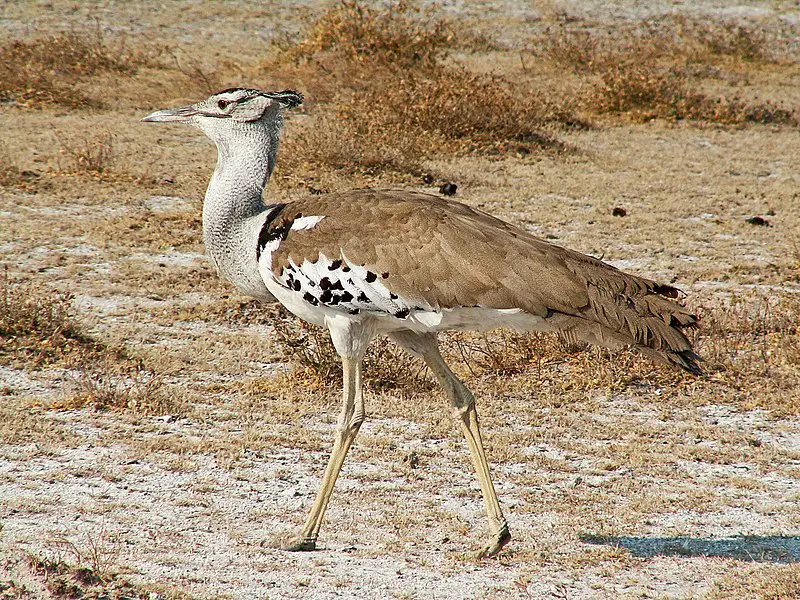
The Kori Bustard is the largest flying bird native to Africa and part of the bustard family. It has a large body, with males reaching up to 20kg in weight – making it one of the heaviest living animals capable of flight.
Its range covers most African countries from Ethiopia all the way down south towards South Africa.
The Kori Bustard is omnivorous and feeds on insects, small lizards, seeds, fruit and even carrion if available.
Their feathers are mostly brownish grey while their heads have black stripes running over them which makes them easily identifiable when seen in its natural habitat.
They usually live alone or in pairs during breeding season but will gather into larger groups at other times throughout their lives; typically nesting on dry open grasslands near water sources for easy access to food and drink.Scientific classification:
| Kingdom | Animalia |
| Phylum | Chordata |
| Class | Aves |
| Order | Otidiformes |
| Family | Otididae |
| Genus | Ardeotis |
| Species | A. kori |
2. Sunbird
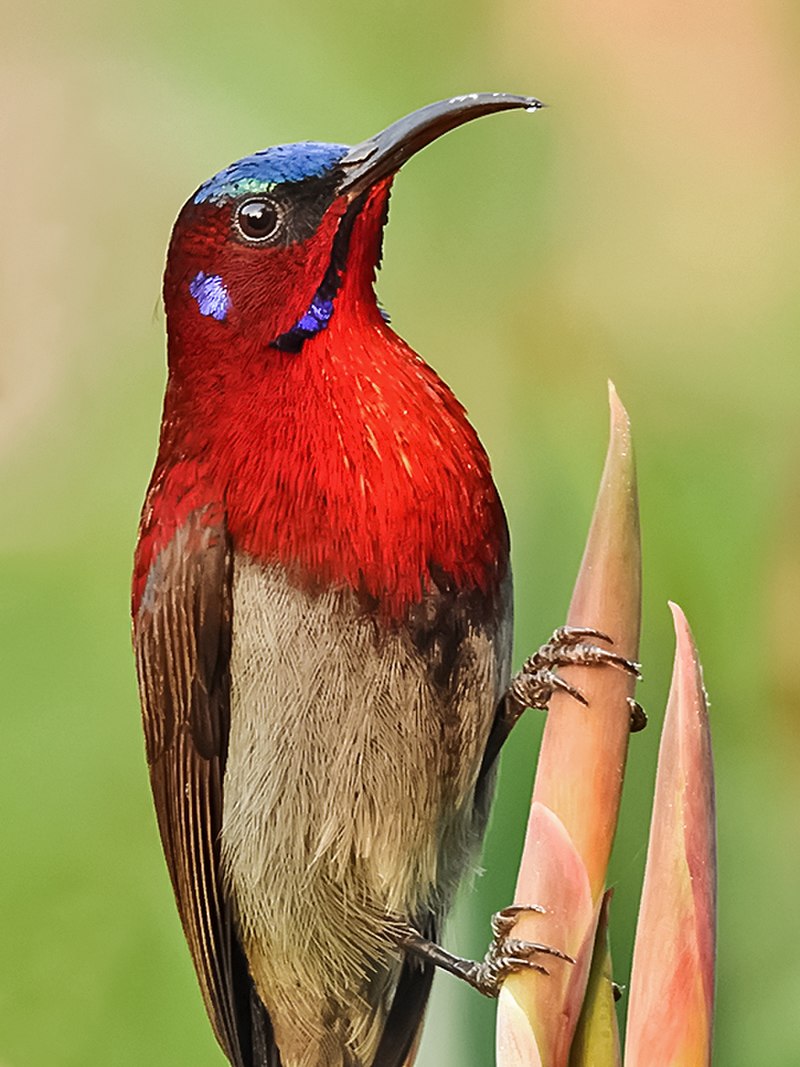
Sunbirds are a family of passerine birds known as the Nectariniidae, found mainly in Africa and parts of Asia. These small, slender birds have downward-curved bills and often feature brightly coloured iridescent feathers.
The males usually display longer tail feathers than females. Sunbird diets consist mostly of nectar from flowers which they sip using their long bill while hovering above them like hummingbirds do.
They also eat insects such as spiders and moths to supplement their nutrition needs.
Sunbirds can be seen flitting around gardens or parks looking for food sources – sometimes alone but more commonly in pairs or families during breeding season when they become quite territorial over an area where they feed on plants with abundant supplies of nectar.Scientific classification:
| Kingdom | Animalia |
| Phylum | Chordata |
| Class | Aves |
| Order | Passeriformes |
| Superfamily | Passeroidea |
| Family | Nectariniidae Vigors, 1825 |
3. Lilac-Breasted Roller
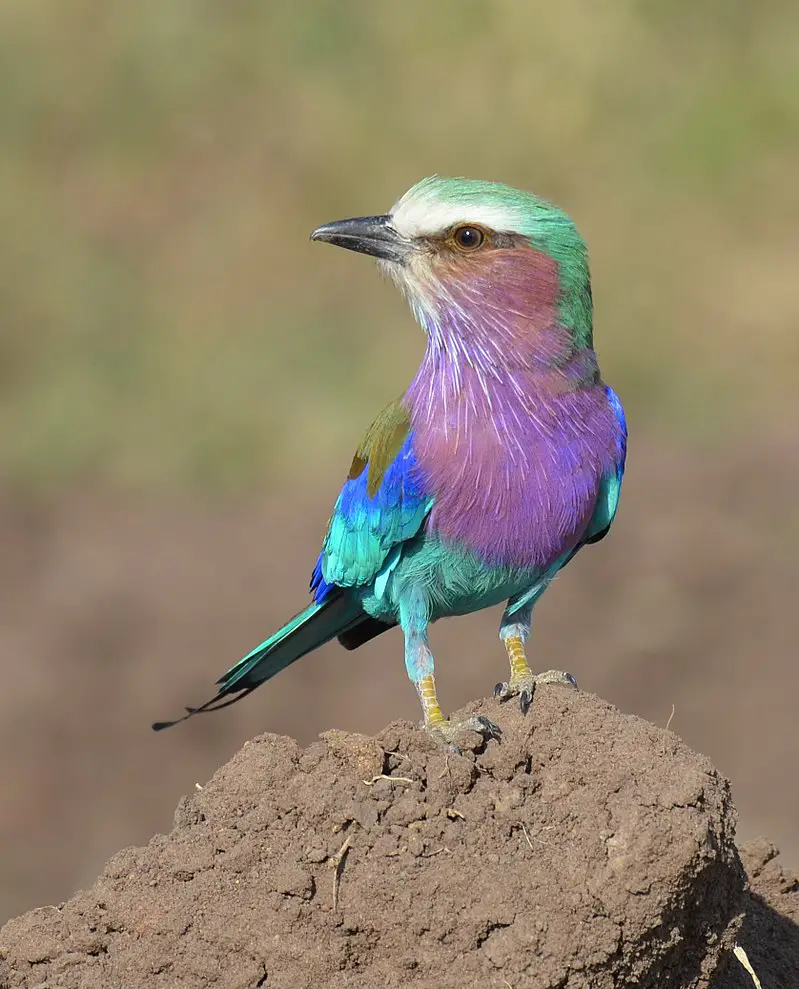
The Lilac-breasted Roller is a spectacular bird native to Southern and Eastern Africa, with occasional appearances in the southern Arabian Peninsula.
With its bright purple chest plumage and distinct black stripes on its wings and tail feathers, it stands out among birds of the same family.
It is usually found alone or in pairs perched atop trees or other high viewpoints, often used as lookout points for predators.
This species prefers open areas such as woodlands and savannas; it avoids treeless places like deserts due to their lack of protection from potential dangers.
Its call is loud and melodious – an unmistakable sound echoing through African skies.Scientific classification:
| Kingdom | Animalia |
| Phylum | Chordata |
| Class | Aves |
| Order | Coraciiformes |
| Family | Coraciidae |
| Genus | Coracias |
| Species | C. caudatus |
4. Grey Crowned Crane

The Grey Crowned Crane is a beautiful bird native to eastern and southern Africa. It belongs to the crane family, Gruidae, and its stunning plumage consists of grey feathers topped with golden crowns on their heads.
This species has become Uganda’s national bird due to its gracefulness in flight as well as for being an important part of local cultures across the continent.
The Grey Crowned Crane stands out from other birds not only because of its colorful appearance but also because it performs elaborate mating dances involving leaps, bows, throwing their head back or flapping wings while calling loudly – all in an effort to attract a mate.
In addition to these displays they are highly social animals that form strong bonds with one another and can live up 20 years if given proper care.Scientific classification:
| Kingdom | Animalia |
| Phylum | Chordata |
| Class | Aves |
| Order | Gruiformes |
| Family | Gruidae |
| Genus | Balearica |
| Species | B. regulorum |
Also Featured In: Famous Paintings Birds, African Birds
5. White-Browed Coucal
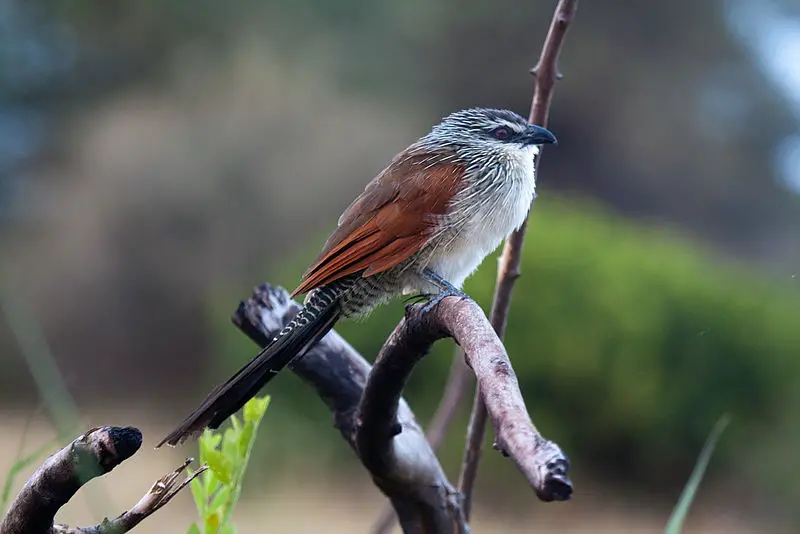
The White-browed Coucal is a species of bird belonging to the Cuculidae family. It can be found in sub-Saharan Africa, inhabiting thick vegetation and rank undergrowth as well as coastal regions.
This medium-sized cuckoo has a length between 36 and 42 cm and is sometimes considered a subspecies of Burchell’s coucal.
Its main distinguishing feature is its white eyebrow which extends towards the back of its head, giving it an elegant look that makes it stand out from other birds in its habitat.
Additionally, this species also features black plumage with some yellow spots on their wings and tail feathers for extra beauty points.
All in all, these fascinating creatures make great additions to any wildlife enthusiast’s list of spotted animals.Scientific classification:
| Kingdom | Animalia |
| Phylum | Chordata |
| Class | Aves |
| Order | Cuculiformes |
| Family | Cuculidae |
| Genus | Centropus |
| Species | C. superciliosus |
Also Featured In: Birds that You’ll Find in Kruger national park, Birds of KwaZulu-Natal
6. Hamerkop
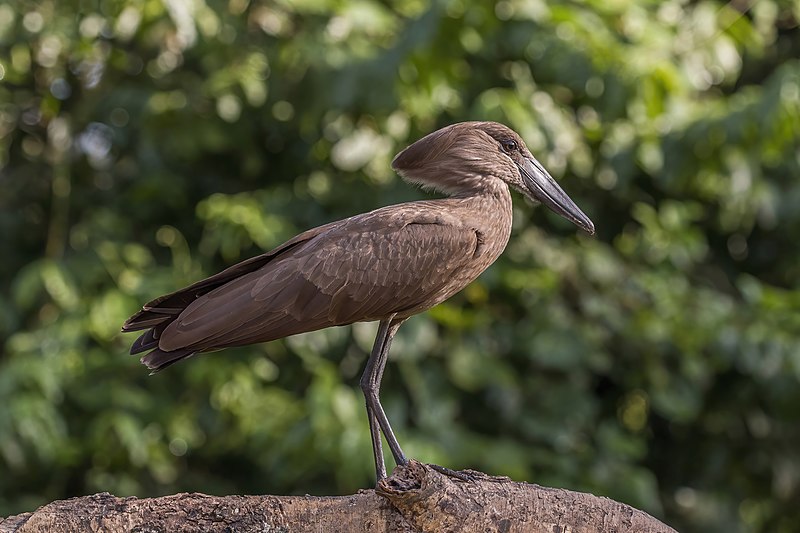
The Hamerkop is a unique wading bird found across sub-Saharan Africa and as far east as India.
It has an unmistakable silhouette, with its long bill topped by a crest at the back of its head that gives it the look of a hammerhead shark.
Its plumage consists mainly of browns and greys, providing excellent camouflage in reed beds.
The species was once classified alongside storks but is now believed to be closely related to pelicans and shoebills instead.
This medium-sized bird feeds on insects, fish, frogs or small reptiles which it captures from shallow water or plucks from trees near bodies of water.
Despite being considered ‘unlucky’ by some cultures due to superstition surrounding their appearance they are actually quite important for controlling populations of certain pests.Scientific classification:
| Kingdom | Animalia |
| Phylum | Chordata |
| Class | Aves |
| Order | Pelecaniformes |
| Family | Scopidae |
| Genus | Scopus |
| Species | S. umbretta |
7. Hornbill
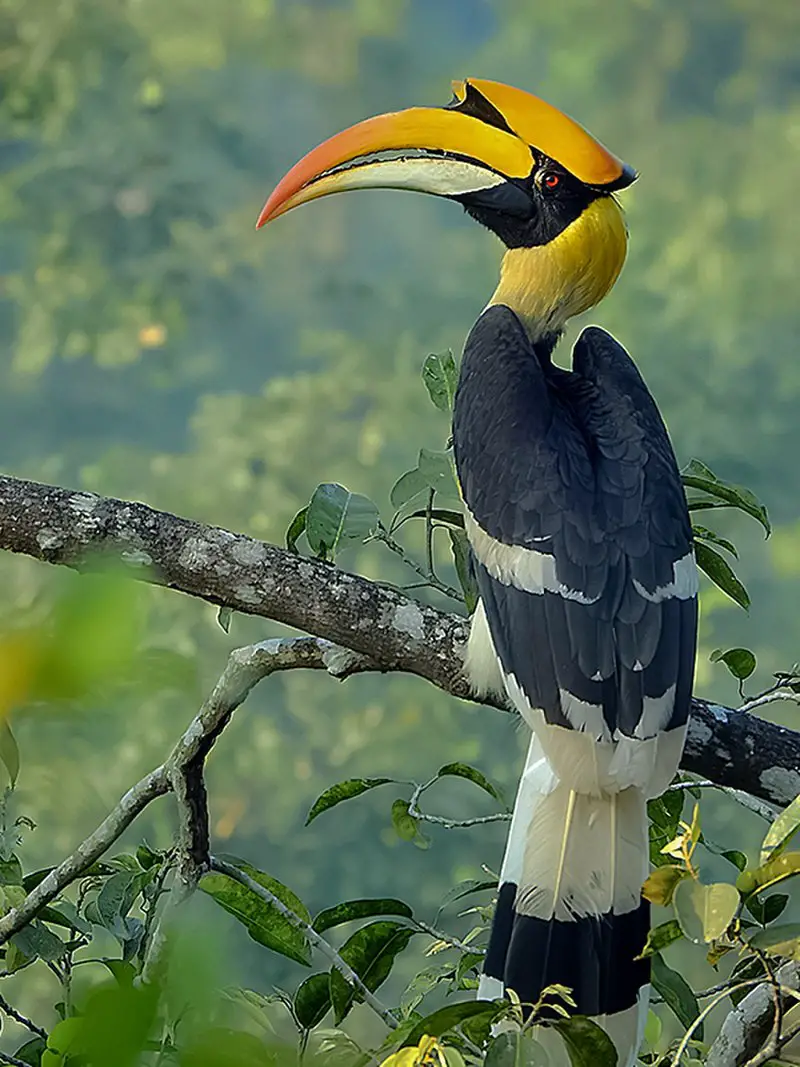
Hornbills are a tropical and subtropical bird species with characteristic long, curved bills. Their English and scientific names both refer to the shape of their bill which resembles that of a cow’s horn.
They have strong beaks for cracking open hard-shelled fruits as well as powerful wings for flying between trees or over great distances in search of food or mates.
Hornbills also feature beautiful plumage ranging from white to black feathers with yellow, brown, red and blue accents on the head, neck and back areas depending on the species.
In addition they often display brightly coloured casques – helmet like structures – atop their upper mandible adding further visual appeal to these majestic birds.Scientific classification:
| Kingdom | Animalia |
| Phylum | Chordata |
| Class | Aves |
| Order | Bucerotiformes |
| Family | Bucerotidae Rafinesque, 1815 |
Also Featured In: Birds That Live in the Jungle, Common Birds in the Cities
8. Knysna Turaco
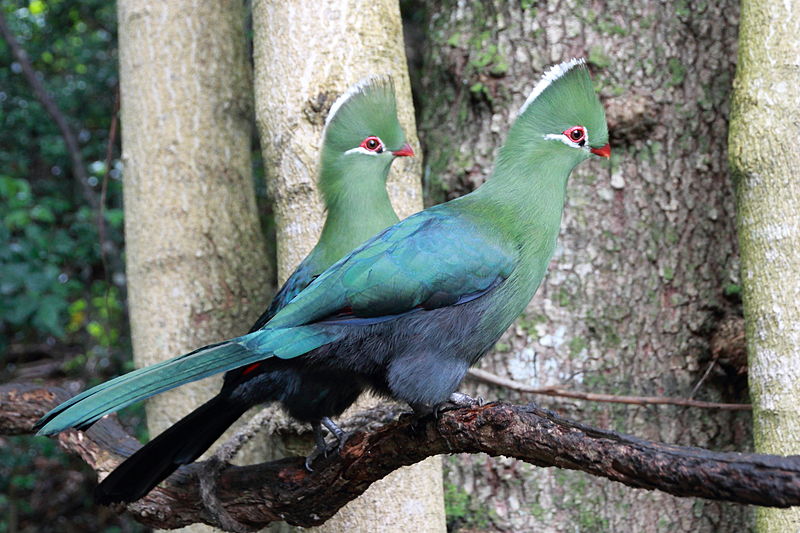
The Knysna Turaco is a vibrant and beautiful bird, native to southern and eastern South Africa as well as Swaziland. It has been classified in the musophagidae family, along with other turacos from all over Africa.
With its bright green feathers, red facial wattles and distinctive yellow crest, this species stands out amongst its peers. Its preferred habitat consists of mature evergreen forests where it can find plenty of food sources such as fruits and insects.
Interestingly enough, at some point the Knysna was considered a subspecies of West African Green Turaco but eventually became recognized on its own unique merits.
This magnificent creature is an incredible sight to behold – you won’t be disappointed if you catch one during your travels.Scientific classification:
| Kingdom | Animalia |
| Phylum | Chordata |
| Class | Aves |
| Order | Musophagiformes |
| Family | Musophagidae |
| Genus | Tauraco |
| Species | T. corythaix |
9. Weavers
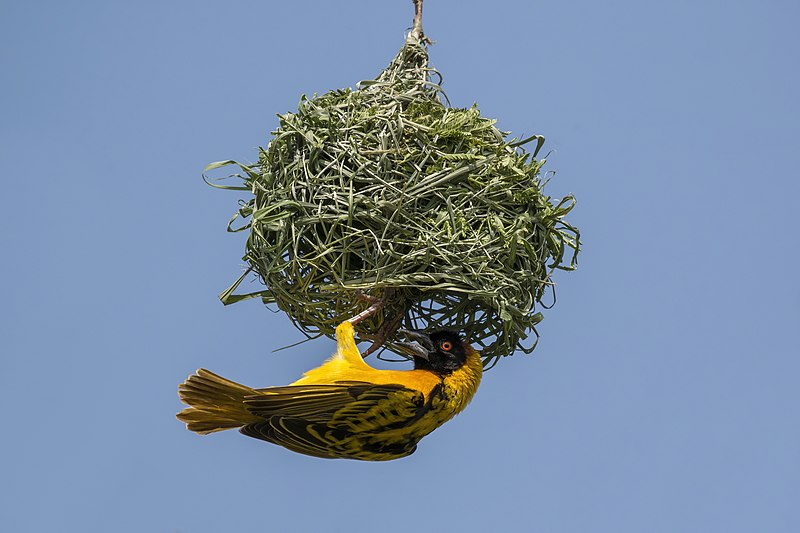
Weaver birds are small passerine birds found in the family Ploceidae. They are known for their intricately woven nests, made from vegetation and other materials sourced locally by the weavers.
These complex structures have earned them their distinctive name, as they appear to weave together a home away from home.
Weaverbirds come in a range of sizes and colours – some are brightly coloured while others may be more subtle or plainer looking – but all share an affinity with weaving material into intricate architectural designs.
Some species also use mud instead of plant life to build these impressive homes. Not only do these feathered architects give us insight into nature’s incredible capacity for problem-solving and resourcefulness; they provide stunningly colourful displays too.Scientific classification:
| Kingdom | Animalia |
| Phylum | Chordata |
| Class | Aves |
| Order | Passeriformes |
| Superfamily | Passeroidea |
| Family | Ploceidae Sundevall, 1836 |
Also Featured In: Most Common Nature Birds, Savanna Birds You Need to See
10. Bustard
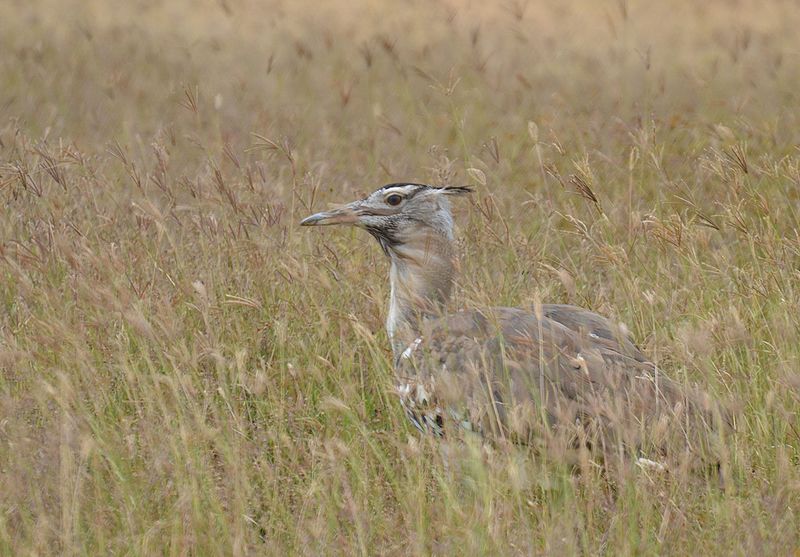
Bustards are large, terrestrial birds that inhabit dry grassland areas and the steppes of the Old World. They range from 40-150 cm in length and belong to the family Otididae.
Bustards have an omnivorous diet consisting of leaves, buds, seeds, fruit as well as small vertebrates and invertebrates.
These birds usually live a solitary life but can be seen gathering around water sources or food during certain times of year such as mating season.
Due to their large size they are vulnerable to predation by foxes or other animals which is why they tend to remain alert at all times.
When in open spaces while relying on camouflage for protection against predators when out in tall vegetation coverings.Scientific classification:
| Kingdom | Animalia |
| Phylum | Chordata |
| Class | Aves |
| Clade | Otidimorphae |
| Order | Otidiformes Wagler, 1830 |
| Family | Otididae Rafinesque, 1815 |
11. African Penguin

African Penguins are native to the waters around South Africa and Namibia. They have black, white and grey plumage with a distinctive pink band on their chest.
The African Penguin is an endangered species with only about 25,000 pairs left in the wild due to overfishing of their food sources as well as oil spills which pollute their habitat.
To help protect them several organizations are working together for conservation efforts such as creating artificial nests and providing medical care when needed.
This has resulted in population increases at some colonies but there’s still more work that needs to be done if we want these beautiful creatures to continue thriving in our oceans for generations to come.
12. Blue Crane
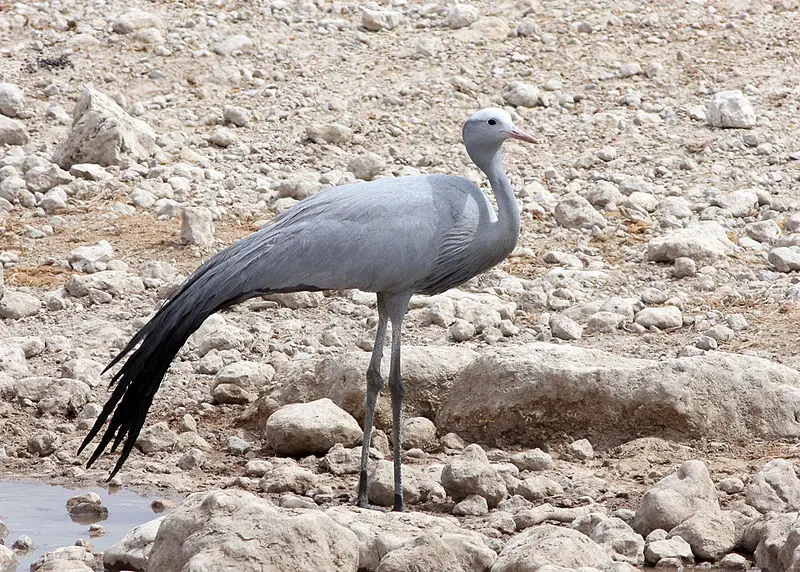
The Blue Crane is a majestic bird native to South Africa, and is the national bird of the country.
Standing at around 3 feet tall and with a wingspan up to 6 ft 7 inches, it has striking plumage that includes an ash-blue head and neck, white belly feathers, black wingtips and grey legs.
Unfortunately this species is listed as Vulnerable by The IUCN due to habitat loss caused by human development activities such as farming or mining.
Despite their vulnerability they are still seen in open habitats like grasslands where they feed on various seeds from plants growing there including wildflowers .
A beautiful sight indeed.Scientific classification:
| Kingdom | Animalia |
| Phylum | Chordata |
| Class | Aves |
| Order | Gruiformes |
| Family | Gruidae |
| Genus | Grus |
| Species | G. paradisea |
Also Featured In: Birds You’ll Find in Zoo,
13. Cape Gannet
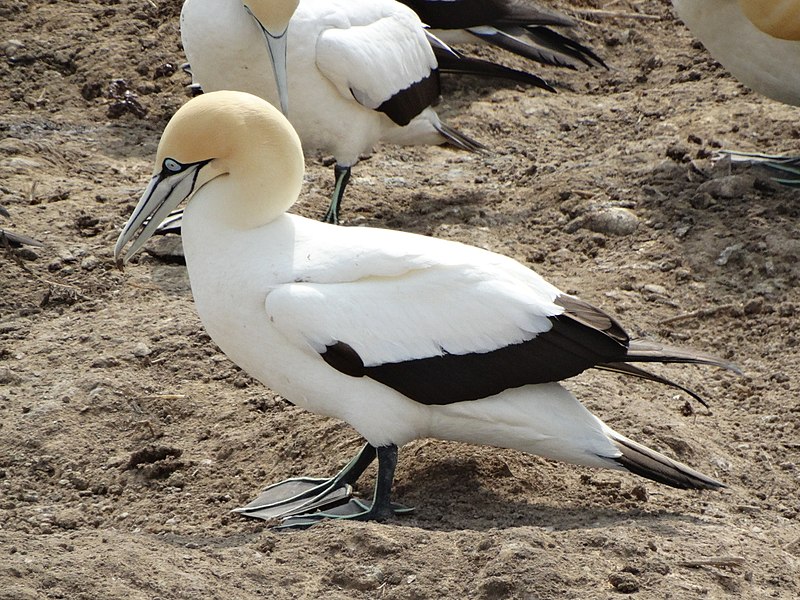
The Cape Gannet is a majestic seabird of the Sulidae family, easily recognised by its large size and striking black-and-white plumage.
Its head and hind neck are strikingly yellow while its pale blue bill is pointed with fine serrations near the tip.
These birds are renowned for their incredible diving abilities; they can plunge up to 25 metres underwater at speeds of over 60 kilometres per hour in pursuit of fish.
The gannets also work together as teams when fishing, creating impressive “bait balls” which draw shoals closer before being devoured.
Their diets mainly consist on small schooling fish such as sardines or anchovies but squid and crustaceans may also be eaten from time to time.
At sea, these remarkable creatures make an unforgettable sight – soaring gracefully above the waves or plunging beneath them in search of food.Scientific classification:
| Kingdom | Animalia |
| Phylum | Chordata |
| Class | Aves |
| Order | Suliformes |
| Family | Sulidae |
| Genus | Morus |
| Species | M. capensis |
14. Grey Go-Away-Bird
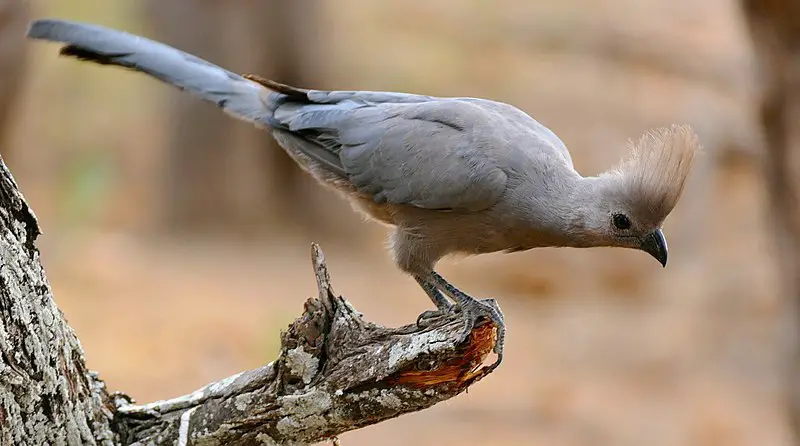
The Grey Go-Away-Bird is a beautiful and vibrant bird native to the southern Afrotropics. It has grey feathers on its body with white edging, making it distinct from other birds in its area.
These bold birds can be seen foraging for food high up in trees or dust bathing on the ground in groups or parties.
When disturbed they make their presence known by producing loud cackling calls that sound like “go away”.
This species of bird prefers arid to moist open woodlands and thorn savanna near surface water which provides them with plenty of opportunities to search for food such as insects and fruits.
All in all, the Grey Go-Away-Bird is an interesting member of the avian community.Scientific classification:
| Kingdom | Animalia |
| Phylum | Chordata |
| Class | Aves |
| Order | Musophagiformes |
| Family | Musophagidae |
| Genus | Corythaixoides |
| Species | C. concolor |
Also Featured In: Johannesburg Birds You Need to Know,
15. Cape Parrot
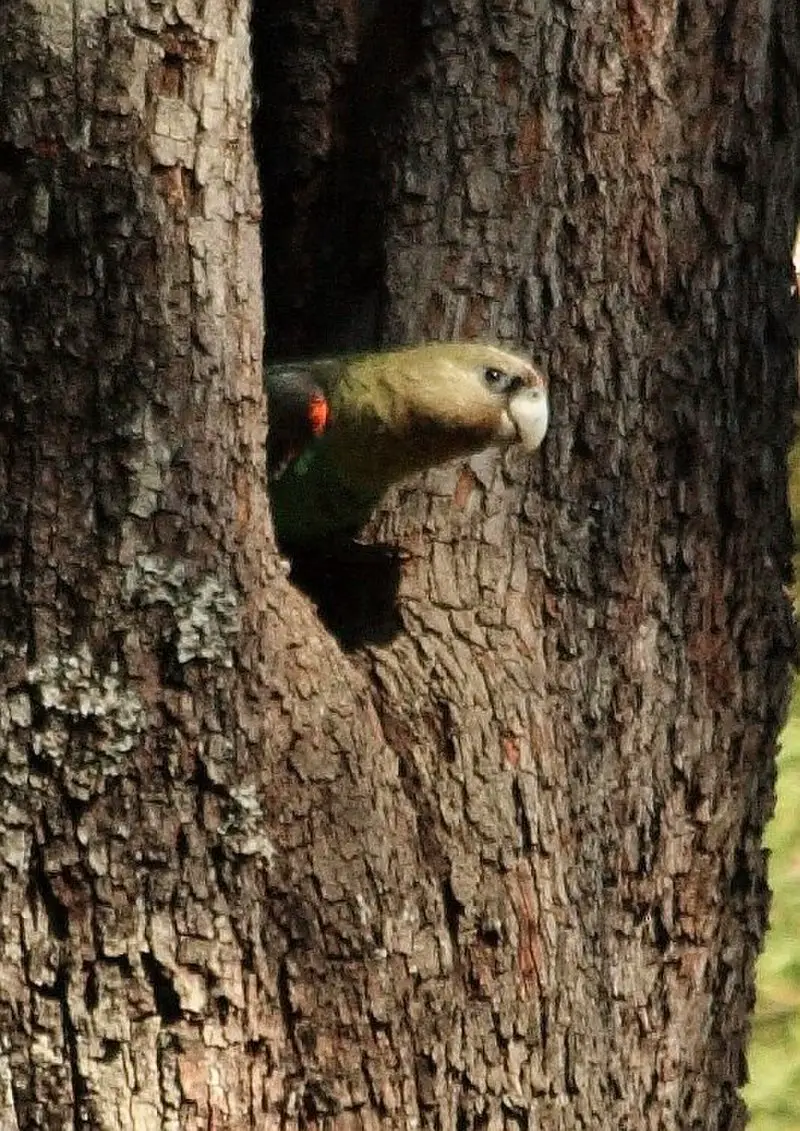
The Cape parrot is a beautiful bird native to South Africa. It has bright green plumage, with blue feathers at the tips of its wings and tail. Its head is greyish-brown in color, and it features a characteristic red beak and eye ring.
This species was formerly grouped as a subspecies along with two other African parrots: the savanna-dwelling brown-necked parrot, Poicephalus fuscicollis; and the grey-headed parrot, Poicephalus suahelicus.
However, recent studies have identified them as distinct species.
The Cape Parrot lives mainly in temperate forests but can also sometimes be found near villages or agricultural areas where food sources are plentiful for them to feed on such as nuts & seeds from trees or grains cultivated by humans.Scientific classification:
| Kingdom | Animalia |
| Phylum | Chordata |
| Class | Aves |
| Order | Psittaciformes |
| Family | Psittacidae |
| Genus | Poicephalus |
| Species | P. robustus |
16. Diederik Cuckoo
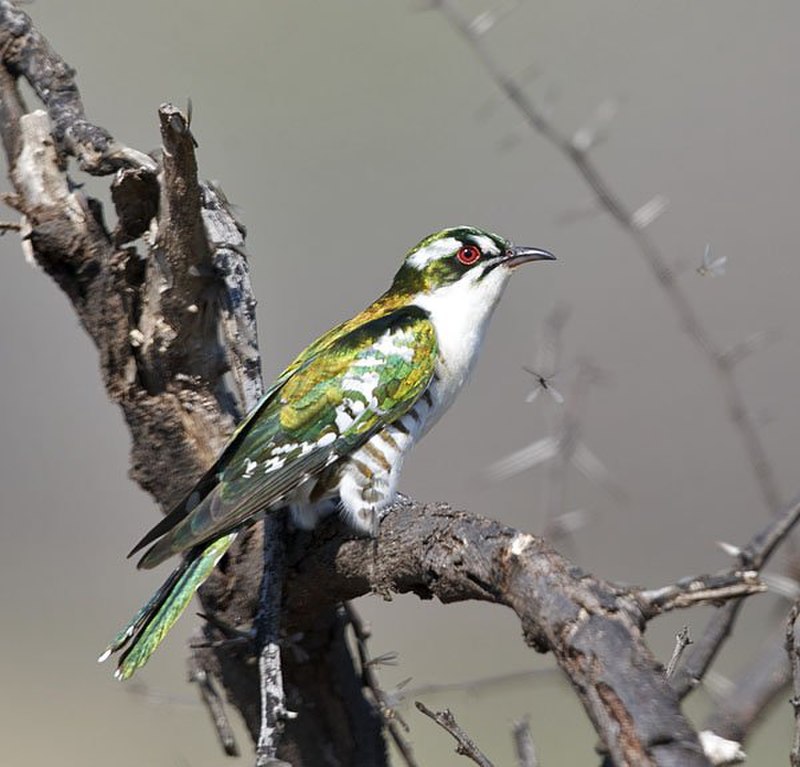
The Diederik Cuckoo is a small and beautiful bird native to the Cape of Good Hope region in South Africa. It has an attractive plumage with black, white and grey feathers covering its body.
Its flight is agile as it soars through the air gracefully on long wings.
The species gets its name from Dutch colonialist Jan van Riebeeck who named it after his friend Diederik Westerwoltz when they encountered one together in 1662 near Table Bay.
This cuckoo prefers open woodlands where they can find their preferred food items like grasshoppers, crickets and caterpillars among others.
They are also known for laying eggs in other birds’ nests which leads to them being adopted by these unsuspecting hosts unknowingly.Scientific classification:
| Kingdom | Animalia |
| Phylum | Chordata |
| Class | Aves |
| Order | Cuculiformes |
| Family | Cuculidae |
| Genus | Chrysococcyx |
| Species | C. caprius |
Also Featured In: Birds of Etosha National Park,
17. Knysna Woodpecker
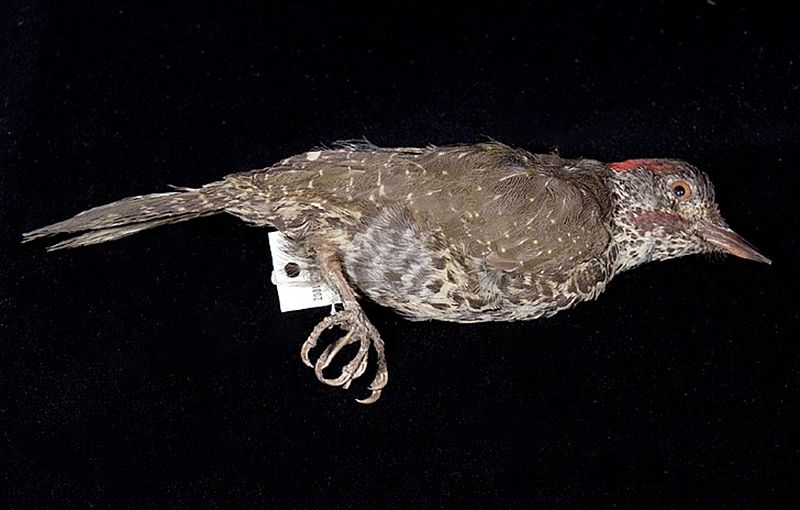
The Knysna woodpecker is an endemic species of bird found in South Africa. It inhabits subtropical or tropical moist lowland forests, moist savanna and shrublands.
This particular woodpecker belongs to a complex family which also includes the golden-tailed and Mombasa woodpeckers.
Sadly this beautiful creature is threatened by habitat loss due to human activity such as deforestation for development purposes, making it vulnerable to extinction if not protected properly soon enough.
The colorful plumage of the Knysna Woodpecker consists mainly of shades of grey with red under its wings and tail feathers plus yellow markings on its face make it quite attractive.Scientific classification:
| Kingdom | Animalia |
| Phylum | Chordata |
| Class | Aves |
| Order | Piciformes |
| Family | Picidae |
| Genus | Campethera |
| Species | C. notata |
18. Bee-Eater
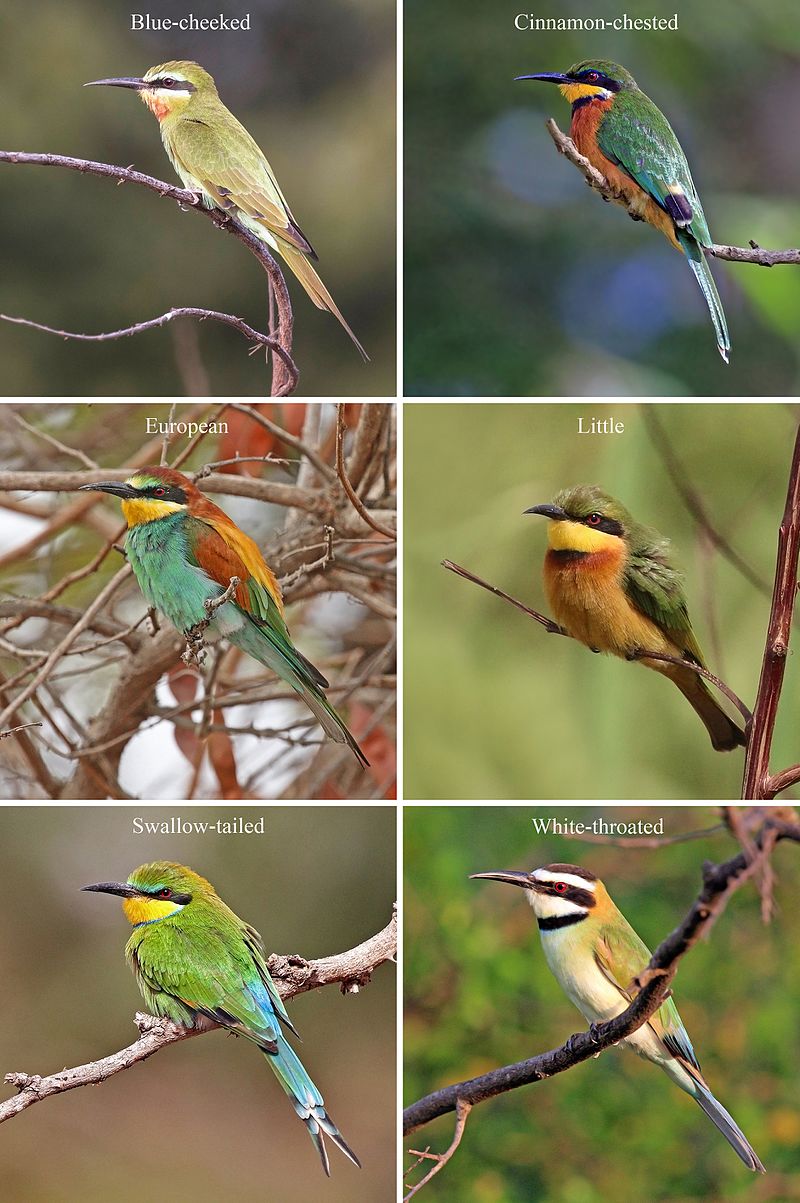
Bee-eaters are one of the most beautiful and vibrant birds in existence. They have a slender body, long wings, down turned bills and their signature elongated central tail feathers which make them instantly recognizable from afar.
Their plumage is incredibly colorful with many shades ranging from blues to greens to reds that glisten when they fly through the air.
These stunning creatures can be found all over Africa, Asia, Southern Europe, Australia and New Guinea where they feed mainly on bees but also other insects like flies or wasps as well as small mammals such as lizards or rodents.
Bee-eaters live in colonies near rivers or wetlands so that they may easily hunt for food while staying close together for safety purposes.
Additionally it allows them to better display their impressive courtship dances during mating season.Scientific classification:
| Kingdom | Animalia |
| Phylum | Chordata |
| Class | Aves |
| Order | Coraciiformes |
| Family | Meropidae Rafinesque, 1815 |
19. Southern Yellow-Billed Hornbill
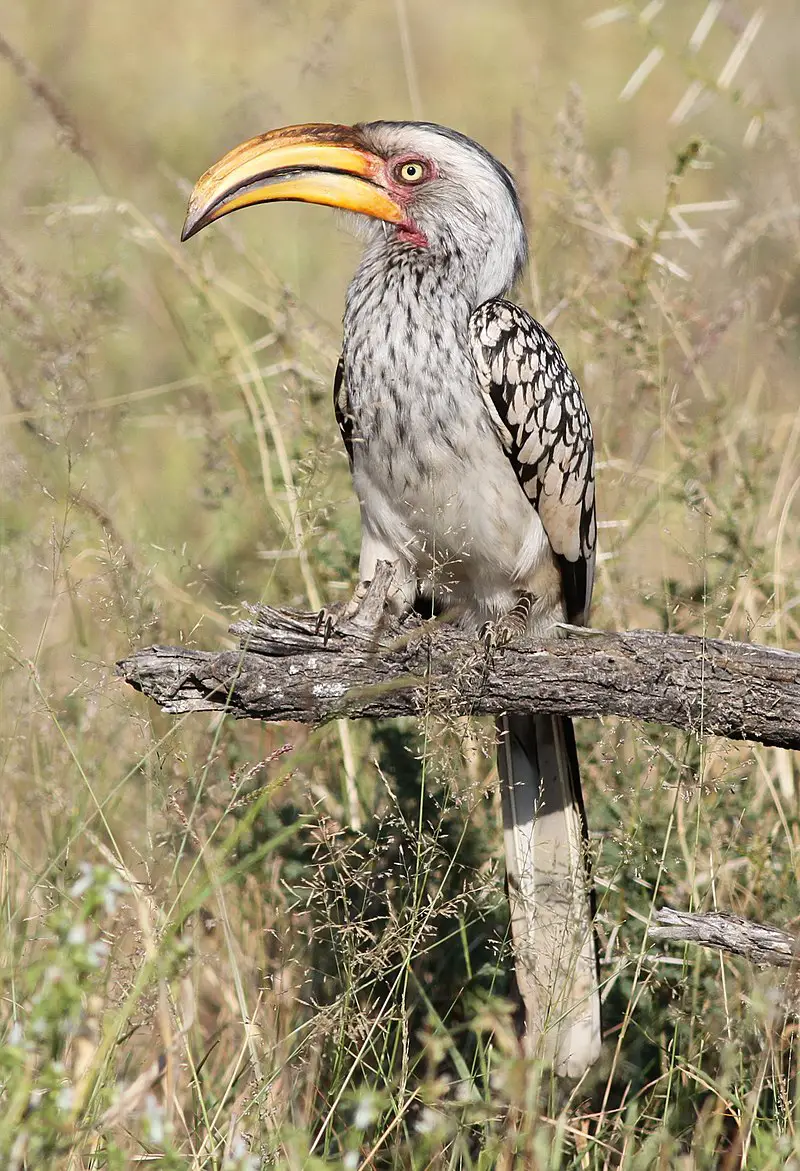
The Southern yellow-billed hornbill is a species of medium sized bird found in southern Africa. It feeds mainly on the ground, foraging for seeds, insects, spiders and scorpions.
These birds are quite common and can be seen along roadsides and water courses due to their preference of dry thornveldt as well as broad-leafed woodlands.
They have bright yellow bills which make them easily recognizable among other birds.
The average length of these beautiful creatures range between 40 – 48 cm with an impressive wingspan reaching up to 90 cm wide.
This stunning species is considered vulnerable by IUCN since it’s numbers are slowly declining due to hunting activities and habitat destruction from urbanization.Scientific classification:
| Kingdom | Animalia |
| Phylum | Chordata |
| Class | Aves |
| Order | Bucerotiformes |
| Family | Bucerotidae |
| Genus | Tockus |
| Species | T. leucomelas |
Also Featured In: Birds You’ll Find in Kenya Safari, Large African Birds You Need to Know
20. Hartlaub’s Gull
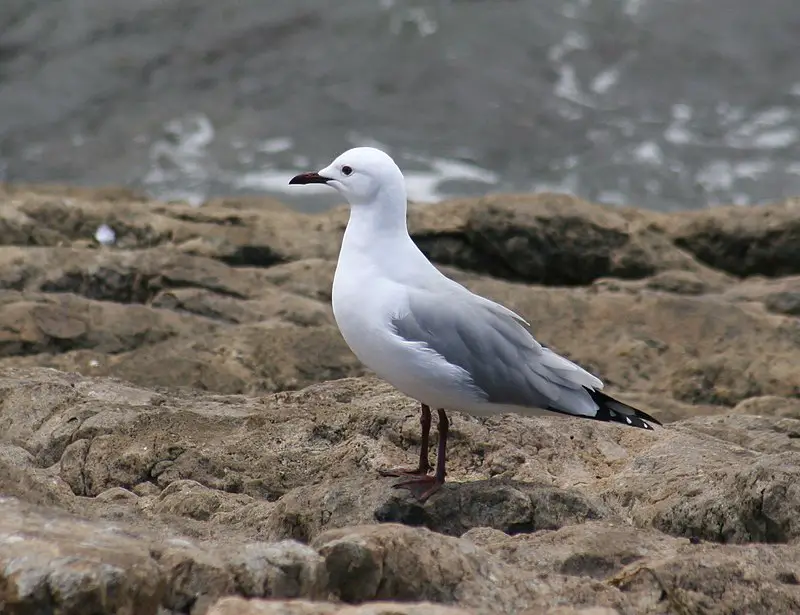
Hartlaub’s gull, also known as the king gull, is a small species of seagull found in parts of Africa and Asia. It was once thought to be subspecies of silver gull but has since been placed within its own genus Chroicocephalus.
The bird was named after German zoologist and physician Gustav Hartlaub who first described it in 1857.
This species usually have grey-brown upperparts with a yellow bill that appears black at times due to the amount darkness on their plumage.
They mainly feed on fish, crustaceans and insects which they hunt from rocky shores or mudflats near coasts or estuaries.
These birds often form flocks when foraging for food making them highly visible by shoreline visitors especially during summer months when they breed along coastal areas throughout their range annually laying 2–3 eggs at each nest site built atop cliffs or ledges either alone or amongst other nesting sea birds such as cormorants and terns.Scientific classification:
| Kingdom | Animalia |
| Phylum | Chordata |
| Class | Aves |
| Order | Charadriiformes |
| Family | Laridae |
| Genus | Chroicocephalus |
| Species | C. hartlaubii |
Also Featured In: Birds That Live around Gull Rock,
21. Grey-Winged Francolin
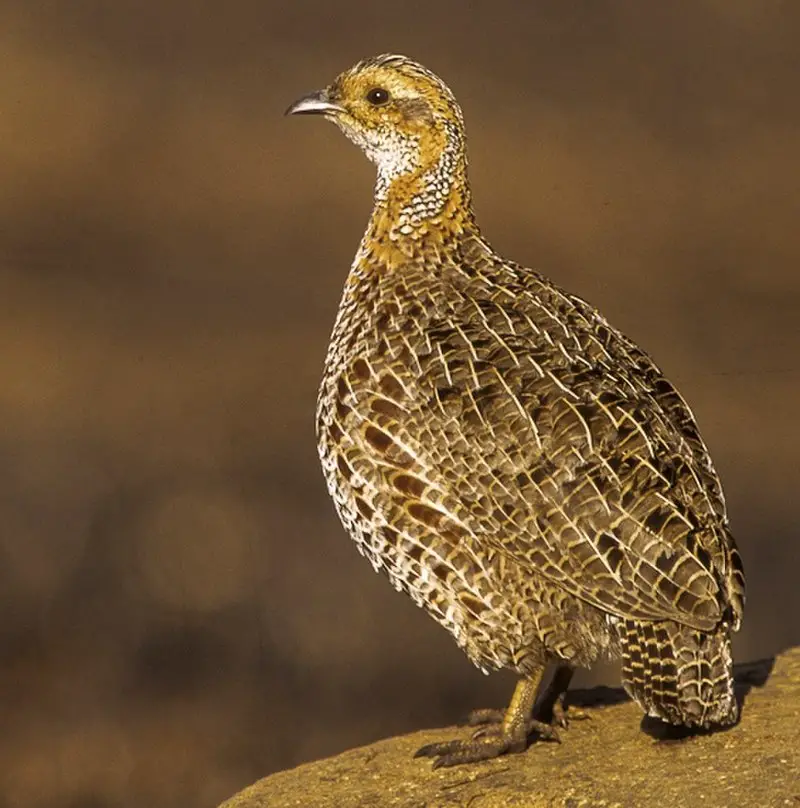
The Grey-winged Francolin is a species of bird belonging to the family Phasianidae. It can be found in Lesotho and South Africa, where it inhabits grassy areas near rivers or streams.
The francolin has grey wings with white spots on them, as well as black tail feathers and a red bill.
Its underparts are mostly dark brown and its head has black stripes running from eye to nape that blend into one another at the back of its neck for an impressive display.
This ground dwelling bird feeds mainly on insects, but will also eat seeds if available during lean times.
They form small flocks when feeding together before roosting high up in trees overnight to avoid predators like snakes or cats.
In general they prefer open spaces such as savannahs but may venture into more densely forested regions too – making them quite adaptable birds indeed.Scientific classification:
| Kingdom | Animalia |
| Phylum | Chordata |
| Class | Aves |
| Order | Galliformes |
| Family | Phasianidae |
| Genus | Scleroptila |
| Species | S. afra |
22. Cape Shoveler
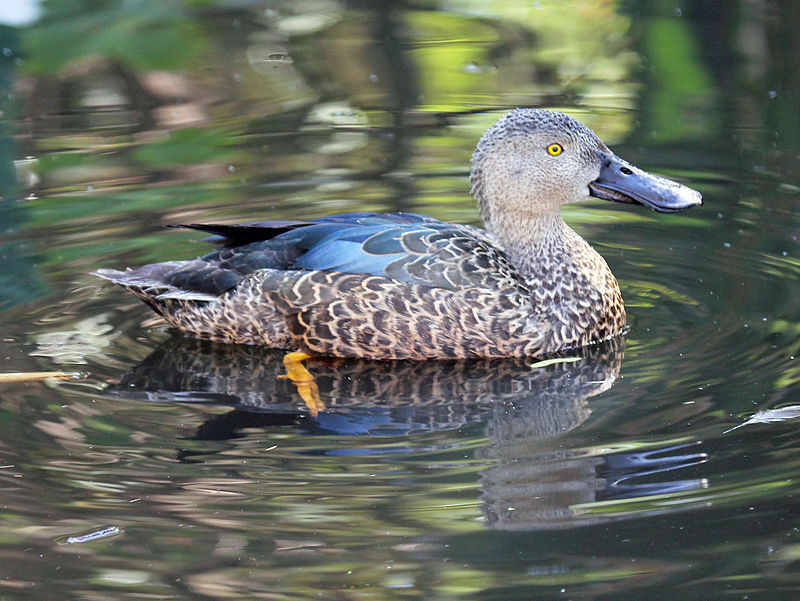
The Cape shoveler is a species of dabbling duck that can be found from South Africa, Namibia, Botswana, Zimbabwe and other parts of southern Africa. It is a non-migratory bird but does some local seasonal movements.
Measuring at 51 to 53 cm in length on average it forms large flocks when not breeding. They have an unmistakable appearance with the males having bright yellow eyes and face along with black crowns while females are more dull coloured overall.
The diet mainly consists of seeds and aquatic insects which they filter out through their broad bill making them well adapted for life in wetlands where they live mostly around shallow lakes or slow flowing rivers.
Breeding season usually starts from October onwards during which pairs will build nests close to water before laying eggs anywhere between 2 – 14 per clutch depending on the region as well as environmental factors like food availability etcScientific classification:
| Kingdom | Animalia |
| Phylum | Chordata |
| Class | Aves |
| Order | Anseriformes |
| Family | Anatidae |
| Genus | Spatula |
| Species | S. smithii |
23. Red-Necked Spurfowl
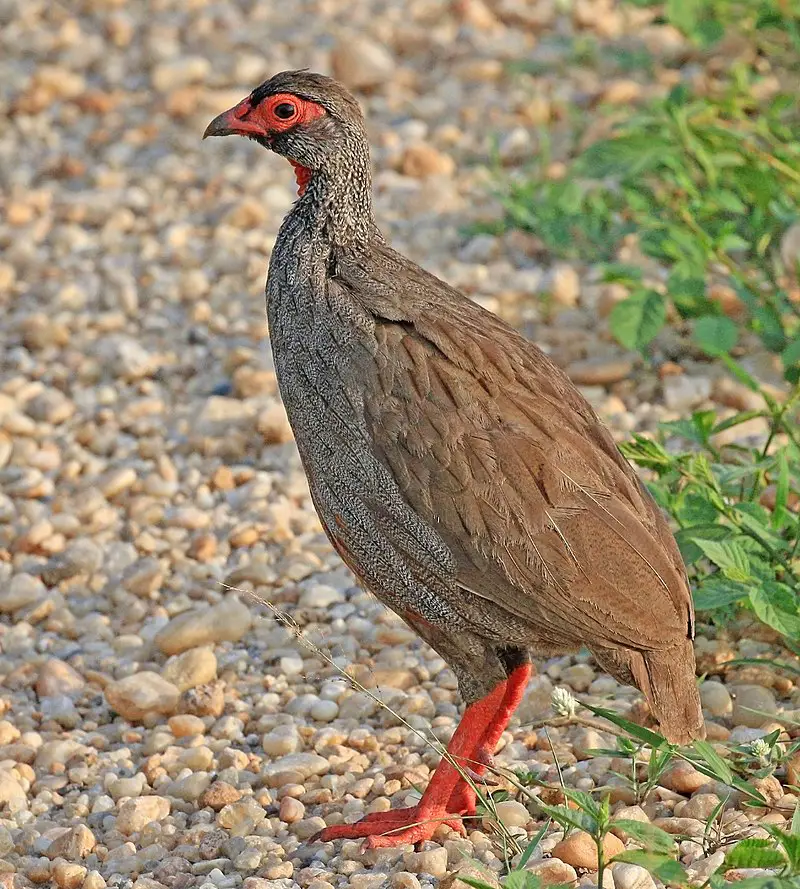
The Red-necked Spurfowl is a gamebird belonging to the pheasant family Phasianidae, and is natively found in southern Africa.
It was first described by German zoologist Philipp Ludwig Statius Müller in 1776 with its type locality being Benguela in western Angola.
This bird has been known for having two distinct colour morphs – greyish or chestnut brown plumage on their back and wings, as well as dark spots near its eyes that are bordered underneath by white stripes.
They also have bright red necks which earned them their name ‘Red-necked’.
These birds can be seen scavenging around human settlements during the day searching for food such as seeds, berries and insects amongst other things like small reptiles.
Despite their small size they are quite capable of defending themselves against predators due to some individuals possessing spurs at the end of each wing joint that act similarly to talons when attacking an enemy.Scientific classification:
| Kingdom | Animalia |
| Phylum | Chordata |
| Class | Aves |
| Order | Galliformes |
| Family | Phasianidae |
| Genus | Pternistis |
| Species | P. afer |
24. Spoonbills
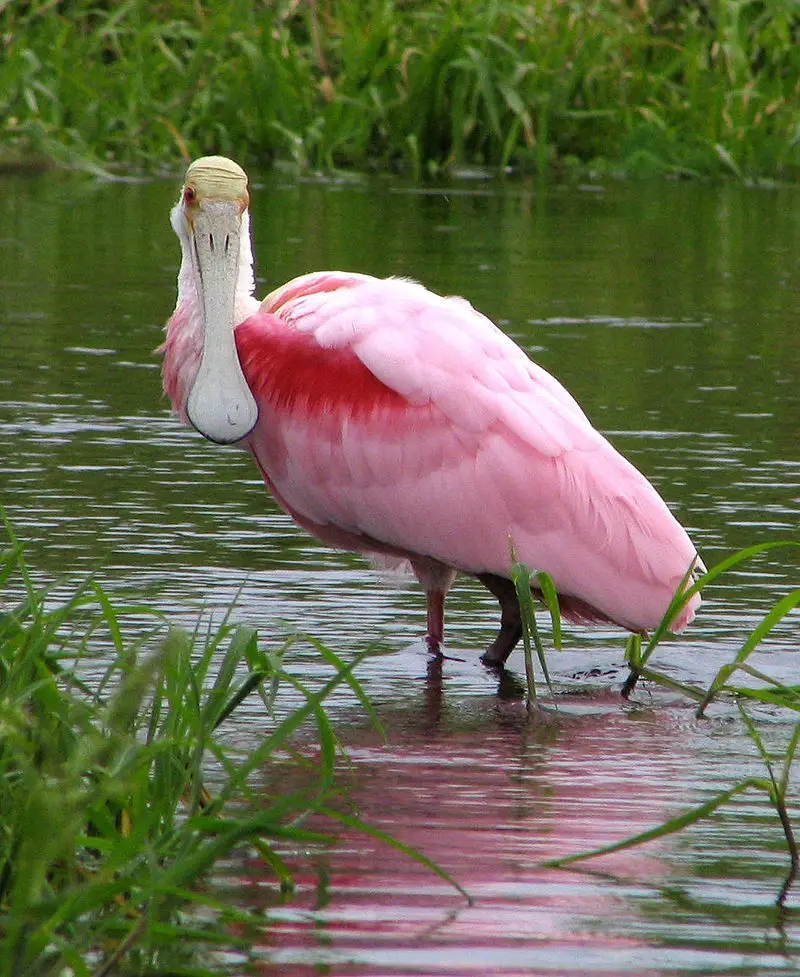
Spoonbills are large wading birds belonging to the genus Platalea. Characterized by their long legs and distinctive spoon-shaped beaks, these birds can be found all over the world except Antarctica.
The name of this genus derives from Ancient Greek meaning “broad”, referring to their bill’s shape.
There are six species of Spoonbill recognized – though they usually form a single group, sometimes it is divided into three genera.
These graceful creatures feed mainly on small aquatic organisms such as insects and fish which they catch with an open-mouth technique while sweeping through shallow waters in search for food.
They typically breed near water bodies during springtime when there’s plenty of food available around them.Scientific classification:
| Kingdom | Animalia |
| Phylum | Chordata |
| Class | Aves |
| Order | Pelecaniformes |
| Family | Threskiornithidae |
| Subfamily | Plataleinae |
| Genus | Platalea Linnaeus, 1758 |
Also Featured In: Birds Found in Hungary, Bulgarian Birds
25. Cape Sugarbird

The Cape sugarbird is a species of bird endemic to the Fynbos biome in South Africa. It has grey-brown plumage with yellow markings on its underside and long tail feathers for males.
Males measure 34–44 cm, while females are shorter and paler brown in colouring. They feed mainly on nectar from flowers such as proteas, ericas, restios and geophytes using their brushy tongues like straws to drink up the sugary liquid.
Although they can eat insects too during periods when food is scarce or difficult to find due to weather conditions. The female builds a nest out of twigs lined with grasses which she will incubate alone until her chicks hatch after about 15 days .
Such an important pollinator means that without them many plants would be unable to reproduce effectively causing detrimental effects throughout entire ecosystems.Scientific classification:
| Kingdom | Animalia |
| Phylum | Chordata |
| Class | Aves |
| Order | Passeriformes |
| Family | Promeropidae |
| Genus | Promerops |
| Species | P. cafer |
26. Saddle-Billed Stork
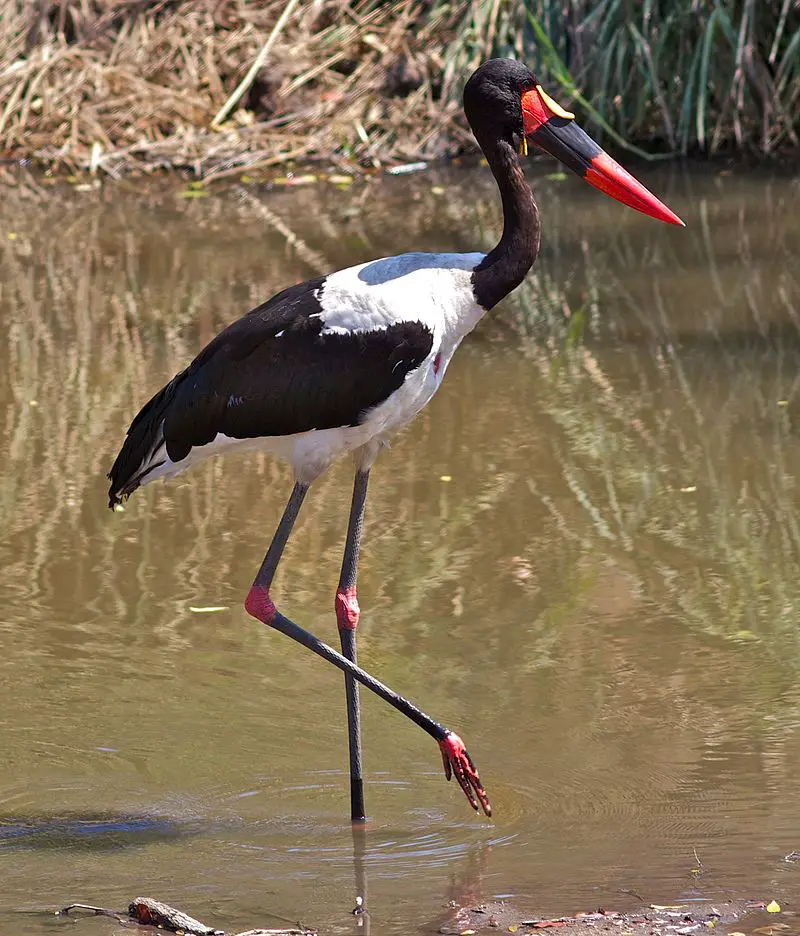
The Saddle-billed Stork is a large wading bird from the stork family, Ciconiidae. It can be found in sub-Saharan Africa and some parts of western Africa.
This majestic bird stands out with its striking features – it has an impressive bill that looks like a saddle and bright red legs which contrast against its white plumage on top.
The Saddle-billed Stork’s diet consists mostly of fish, frogs, aquatic invertebrates as well as small reptiles or mammals they come across while scavenging for food in wetland areas.
Sadly, this species is considered endangered in South Africa due to habitat loss and degradation caused by human activities such as drainage projects and agricultural expansion.
We must take action to protect these beautiful creatures before their numbers decrease further.Scientific classification:
| Kingdom | Animalia |
| Phylum | Chordata |
| Class | Aves |
| Order | Ciconiiformes |
| Family | Ciconiidae |
| Genus | Ephippiorhynchus |
| Species | E. senegalensis |
Also Featured In: East African Birds, Big Birds that Live in Uganda
27. African Jacana
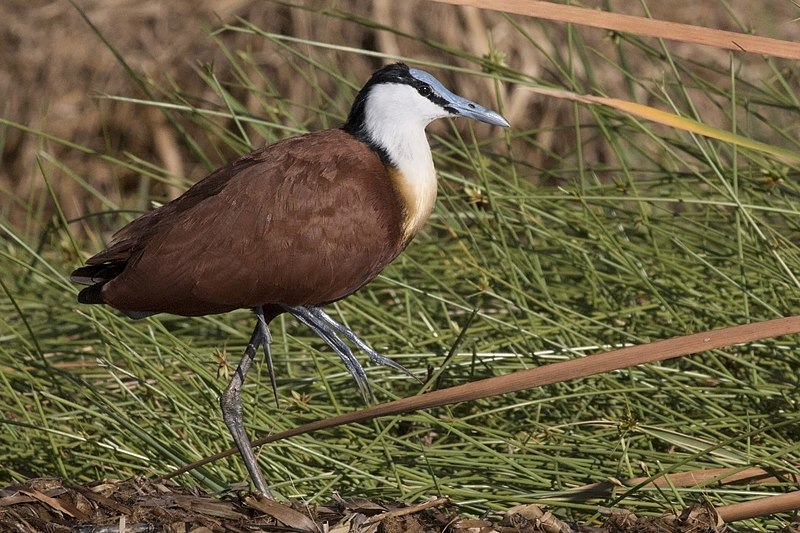
The African Jacana is a charming wader belonging to the family of Jacanidae, mostly found in sub-Saharan Africa.
It has long toes and claws that allow it to walk on floating vegetation in shallow lakes which form its preferred habitat.
The bird was officially described by Johann Friedri in 1789 with an interesting origin and pronunciation for its name -Jacanidae.
This aquatic bird is known for its striking plumage features like yellow crowns and black wings marked with chestnut brown stripes across them, making them look even more attractive when they spread their wing feathers during courtship displays.
They feed mainly on insects, tadpoles, frogs etc., skimming nearby water surface or plucking prey from vegetation as they wander around these wetlands areas.Scientific classification:
| Kingdom | Animalia |
| Phylum | Chordata |
| Class | Aves |
| Order | Charadriiformes |
| Family | Jacanidae |
| Genus | Actophilornis |
| Species | A. africanus |
28. Namaqua Sandgrouse
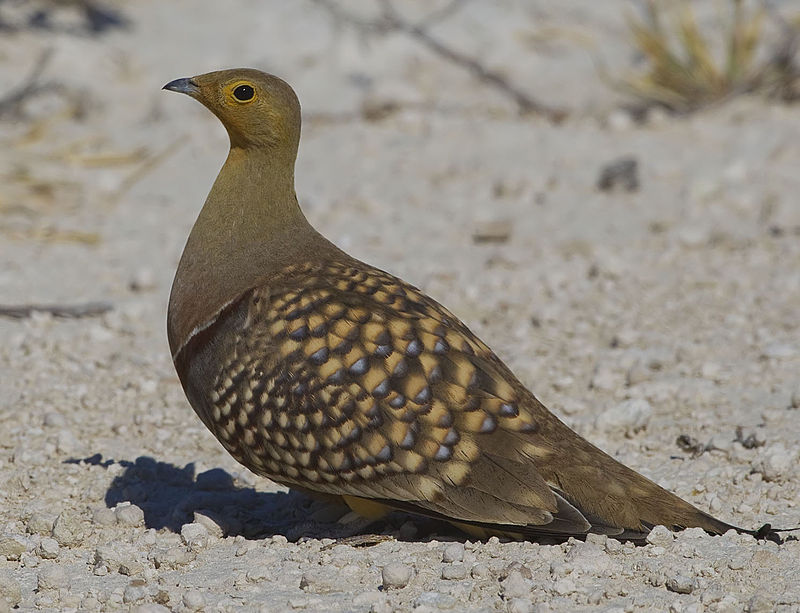
The Namaqua sandgrouse is a species of ground-dwelling bird belonging to the sandgrouse family.
It inhabits arid regions in south-western Africa and was formally described by German naturalist Johann Friedrich Gmelin in 1789 as part of his revised edition of Carl Linnaeus’ Systema Naturae.
Featuring a mottled buff, grey and brown plumage, it has black markings on its wings that help distinguish it from other birds within its range.
The male also displays an eye comb, which consists of two rows of upright feathers forming lengthy tufts around the eyes.
They feed mainly on seeds but will supplement their diet with insects if available during times when food is scarce.
During breeding season they form monogamous pairs who share incubation duties for up to four eggs per clutch before raising them together until they are ready to fledge at approximately 30 days old.Scientific classification:
| Kingdom | Animalia |
| Phylum | Chordata |
| Class | Aves |
| Order | Pterocliformes |
| Family | Pteroclidae |
| Genus | Pterocles |
| Species | P. namaqua |
29. White-Faced Whistling Duck
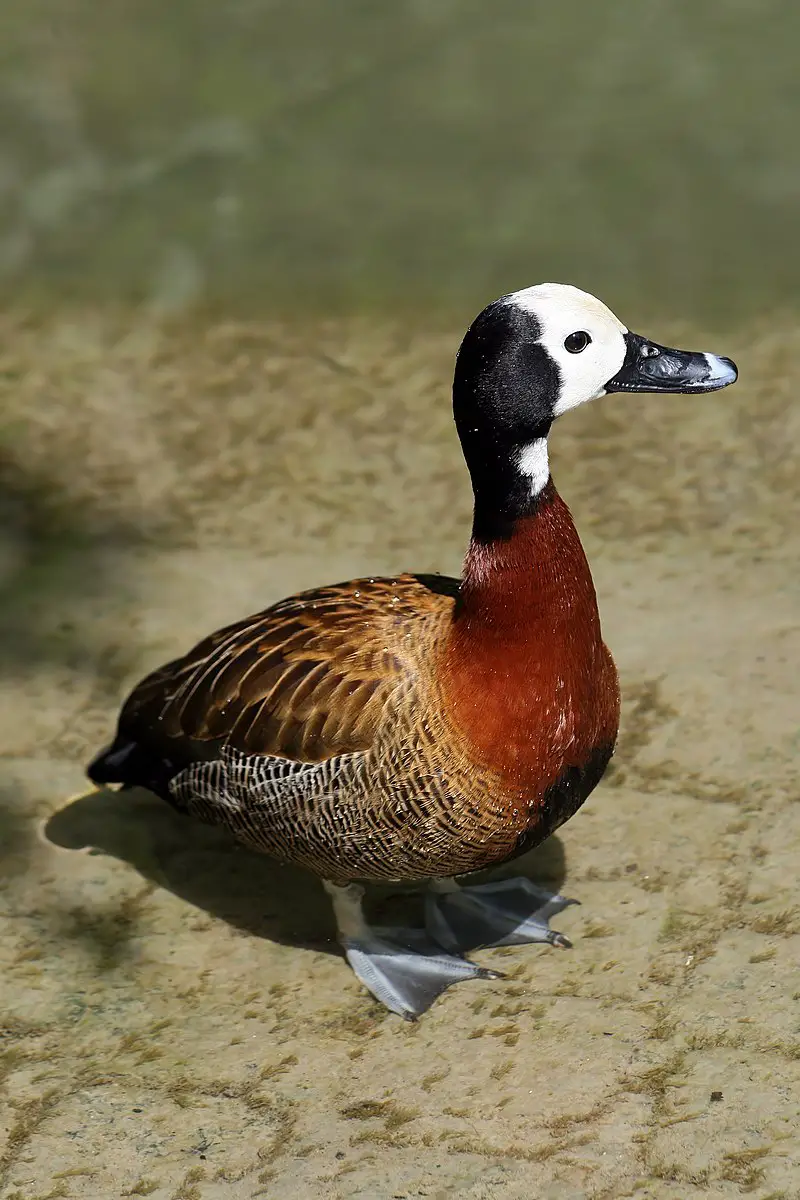
The white-faced whistling duck is a highly social bird native to sub-Saharan Africa and South America. It can be easily identified by its distinct three-note whistling call, as well as its long grey bill.
In the right conditions, it’s not uncommon to spot large flocks of these ducks numbering in the thousands at dawn – an incredible sight.
This species usually lives near bodies of water such as swamps or rivers where they feed on plant matter like grasses and grains which they graze on during the day.
When night falls, they fly off into trees nearby in search of safety from predators before returning to their feeding grounds when morning arrives again.Scientific classification:
| Kingdom | Animalia |
| Phylum | Chordata |
| Class | Aves |
| Order | Anseriformes |
| Family | Anatidae |
| Genus | Dendrocygna |
| Species | D. viduata |
30. Southern Bald Ibis
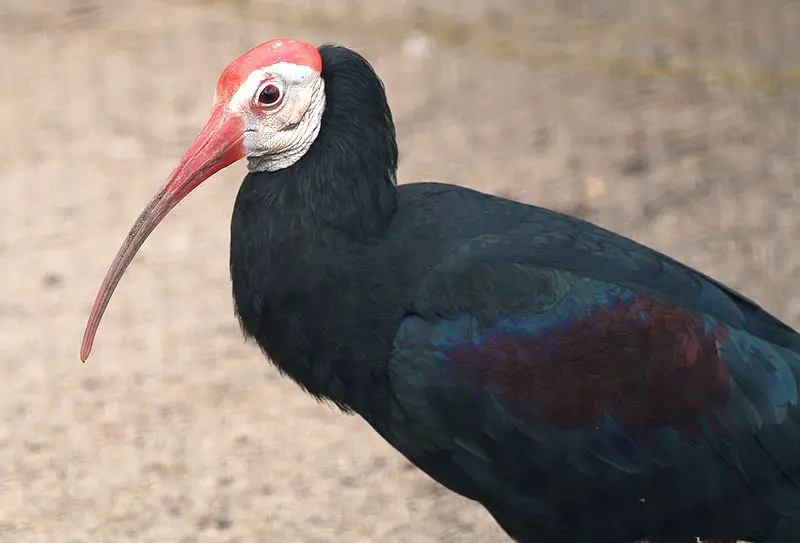
The Southern bald ibis is a large bird native to southern Africa. It can be found in open grasslands and semi-deserts, usually at high altitudes in the mountains.
Taxonomically, it is closely related to its counterpart from northern regions of Africa – the Waldrapp.
This species has an extremely limited homerange, being only present in South Africa’s southernmost areas.
The Southern Bald Ibis stands out due to its distinct black feathers with a greenish gloss on them and bright red skin around their eyes and bill area that contrasts beautifully against its white face.
They mainly feed on snakes, lizards insects or small birds as well as carrion when available..Scientific classification:
| Kingdom | Animalia |
| Phylum | Chordata |
| Class | Aves |
| Order | Pelecaniformes |
| Family | Threskiornithidae |
| Genus | Geronticus |
| Species | G. calvus |
31. Fynbos Buttonquail
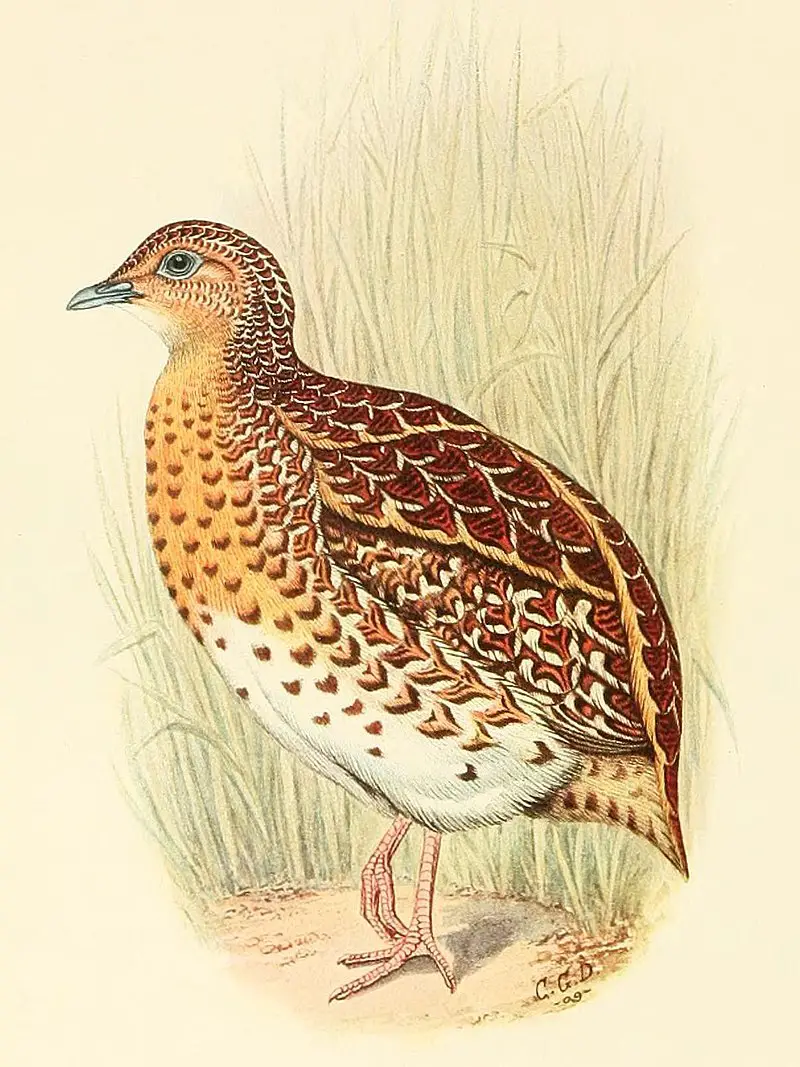
The Fynbos buttonquail is a species of small bird belonging to the Turnicidae family. It was previously thought to be conspecific with the black-rumped buttonquail, but has recently been reclassified as its own species.
This small bird has no subspecies and inhabits areas in South Africa known as fynbos which are characterized by shrubland vegetation. The birds have adapted well to this environment and can often be spotted foraging for food amongst the dense undergrowth.
Due to its offensive connotations, there has been movement towards changing their common name from “Hottentot Buttonquail” to something more sensitive such as “Fynbos Buttonquail” instead .Scientific classification:
| Kingdom | Animalia |
| Phylum | Chordata |
| Class | Aves |
| Order | Charadriiformes |
| Family | Turnicidae |
| Genus | Turnix |
| Species | T. hottentottus |
32. Sandgrouse
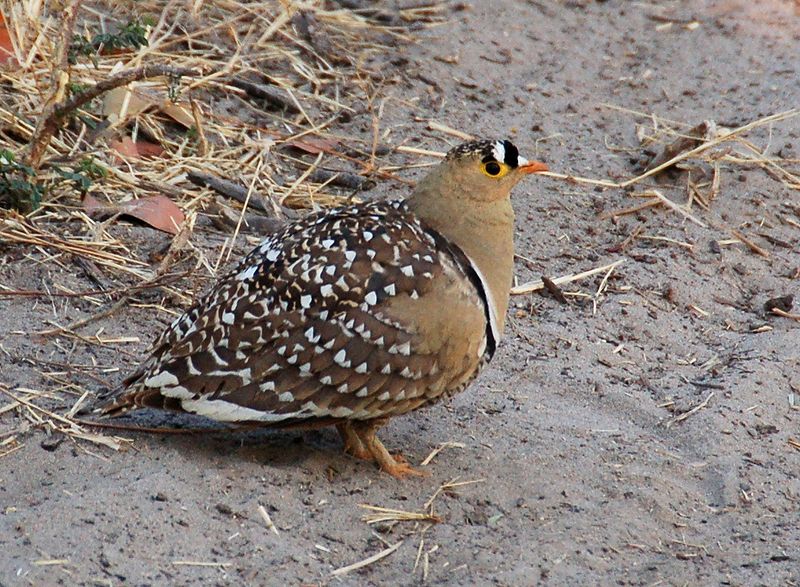
Sandgrouse is birds of the order Pterocliformes, found mainly in Africa and Asia. There are sixteen species belonging to two genera – Syrrhaptes from central Asia and Pterocles from Africa and other Asian countries.
They inhabit treeless areas such as deserts, steppes, scrubland, or savannas and tend to be ground-dwelling birds that feed on seeds.
Sandgrouse has adapted special features for survival in their harsh environment.
They possess well-developed feet with four toes used for walking over hot sand while keeping their body temperature cool at all times by regulating heat loss through their legs.
Their feathers also act like a sponge helping them absorb water before flying long distances back home where they then expel it using specialized glandular secretions located near the wings so that chicks can drink directly from an adult’s breast plumage.Scientific classification:
| Kingdom | Animalia |
| Phylum | Chordata |
| Class | Aves |
| Clade | Columbimorphae |
| Order | Pterocliformes Huxley, 1868 |
| Family | Pteroclidae Bonaparte, 1831 |
33. Yellow-Billed Stork
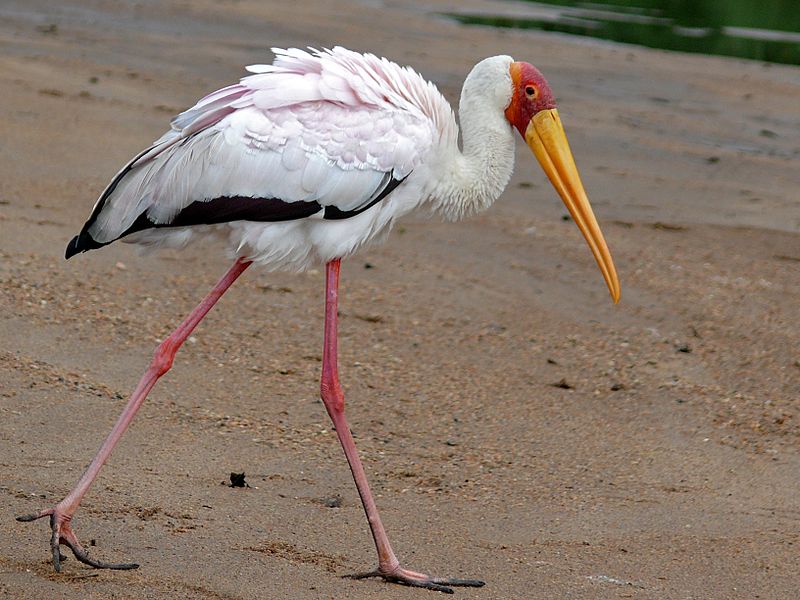
The yellow-billed stork is a large wading bird found in Africa south of the Sahara as well as Madagascar.
It belongs to the family Ciconiidae and has three other species in its genus – Mycteria americana, Mycteria cinerea and Leptoptilos javanicus.
This majestic bird stands at an average height of up to 1 meter with a wingspan that can reach 2 meters wide.
Its plumage is predominantly white with black flight feathers that contrast against its bright yellow bill for which it is named after.
The Yellow-billed Stork feeds on fish, frogs, insects and small reptiles like snakes by probing deep into mud or shallow water bodies using its long beak.
These captivating birds are also known to form colonies during their nesting season from August until October where they build nests out of sticks atop tall trees near wetlands or riversides.Scientific classification:
| Kingdom | Animalia |
| Phylum | Chordata |
| Class | Aves |
| Order | Ciconiiformes |
| Family | Ciconiidae |
| Genus | Mycteria |
| Species | M. ibis |
34. Turaco
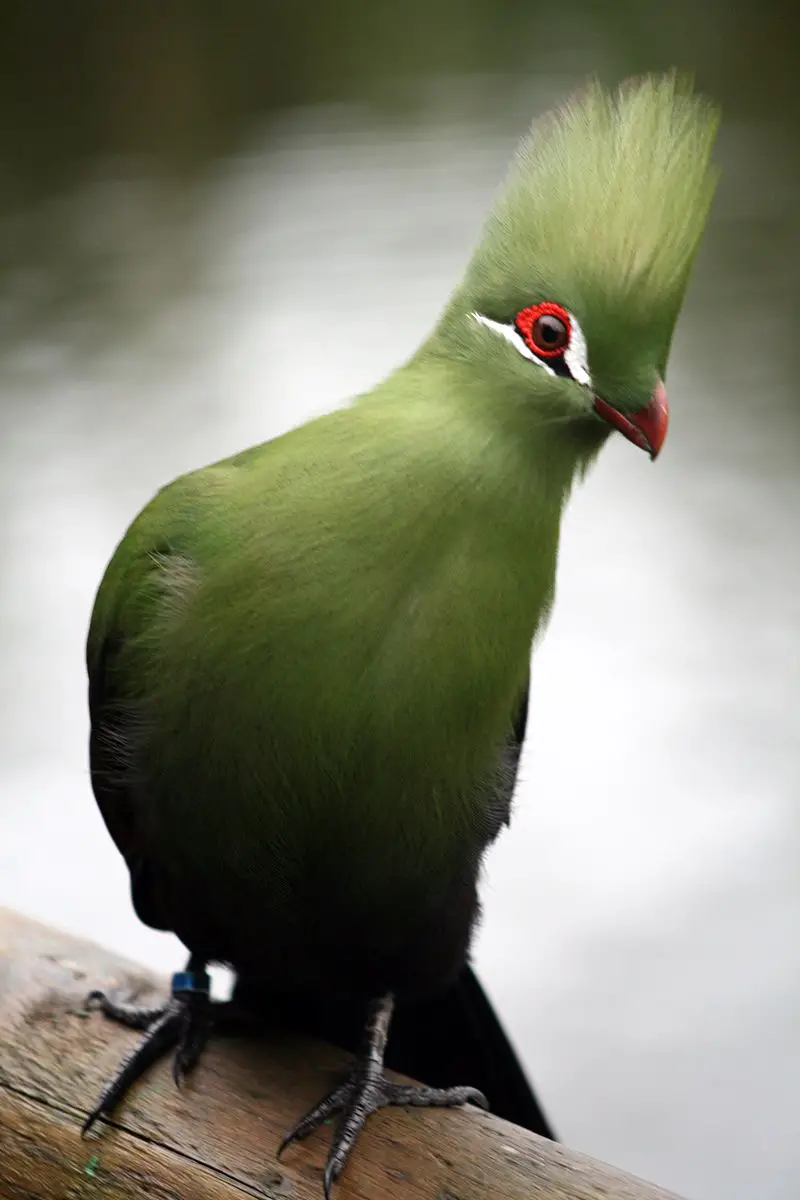
Turacos are a unique bird family that inhabit tropical and subtropical regions of Africa. They are also known as “banana-eaters” or “loeries” in southern Africa, due to their diet which consists mostly of fruit such as plantains.
These birds have an interesting semi-zygodactylous foot structure – the fourth toe can be switched back and forth while the second and third toes remain conjoined.
Turacos come in different sizes depending on species but they all generally boast bright colors like green, blue, purple or red feathers with vibrant yellow eyes.
In addition to being beautiful creatures, these birds make loud calls during mating season which makes them even more special.Scientific classification:
| Kingdom | Animalia |
| Phylum | Chordata |
| Class | Aves |
| Clade | Otidimorphae |
| Order | Musophagiformes Seebohm, 1890 |
| Family | Musophagidae Lesson, 1828 |
35. Pied Kingfisher
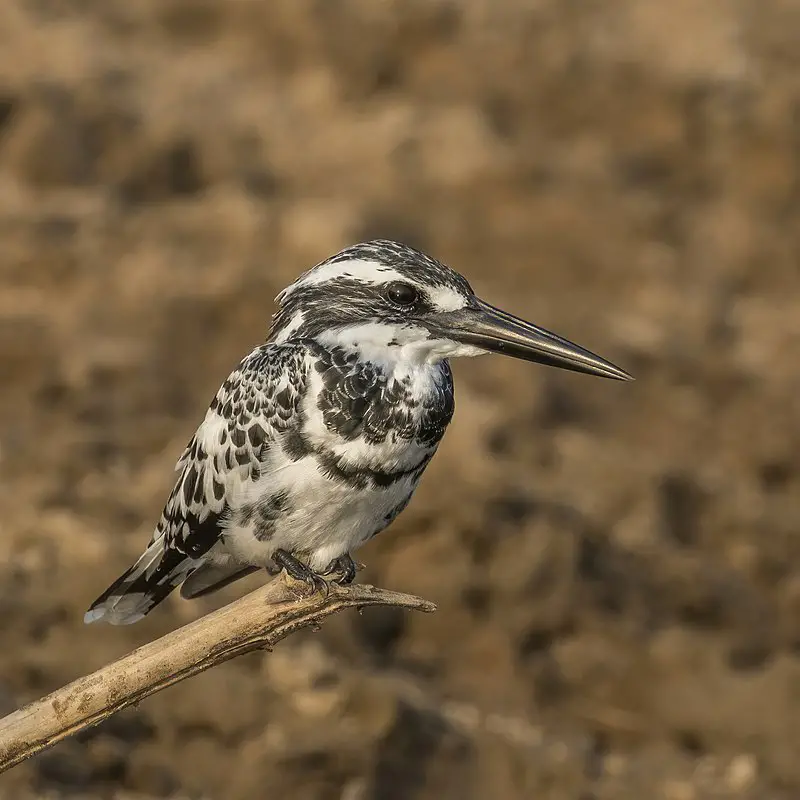
The Pied Kingfisher is a species of water kingfisher found in Africa and Asia. It has black and white plumage, with males sporting a double band across the breast while females have one single band.
This bird makes its presence known by hovering over clear waters before diving for fish – making it easily recognizable.
The diet consists mostly of small aquatic animals such as frogs, crustaceans and insects, but they also consume some plant matter like seeds or fruits occasionally.
The pied kingfisher nests near bodies of water where it can feed off smaller creatures that dwell there; usually in burrows dug into riverbanks or on floating vegetation close to shorelines.
With their distinct colors and behavior patterns these birds make an interesting addition to any wildlife enthusiast’s list.Scientific classification:
| Kingdom | Animalia |
| Phylum | Chordata |
| Class | Aves |
| Order | Coraciiformes |
| Family | Alcedinidae |
| Subfamily | Cerylinae |
| Genus | Ceryle F. Boie, 1828 |
| Species | C. rudis |
36. Northern Black Korhaan
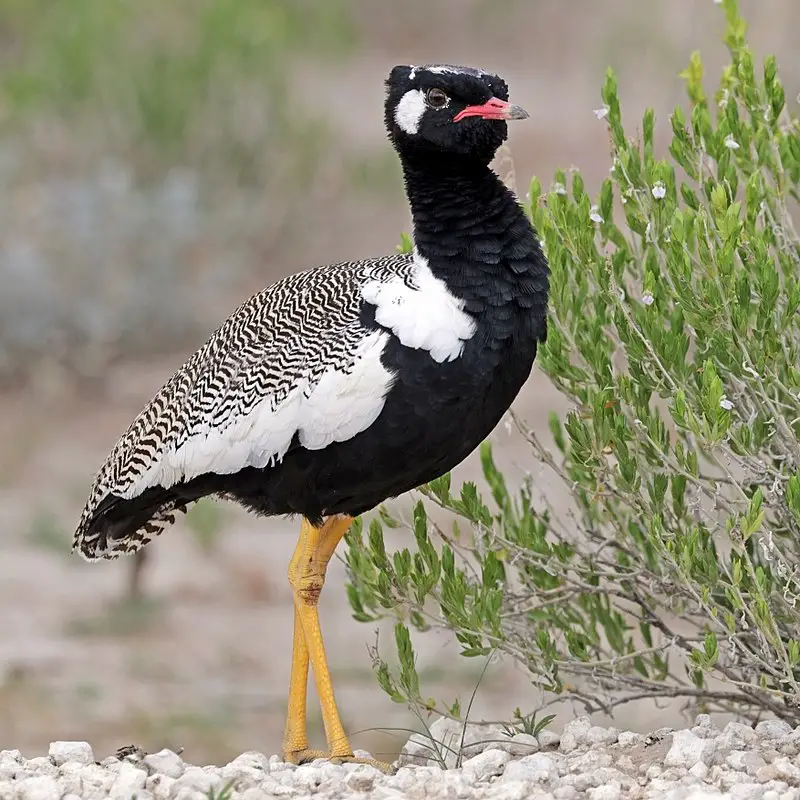
The Northern Black Korhaan, or White-Quilled Bustard, is an impressive bird found across Southern Africa. This species of bustard is highly adapted to open grasslands and scrubland habitats.
It was first discovered by Andrew Smith in 1831 and given the scientific name “afrao”.
The appearance of these birds can vary greatly depending on where they are located; some feature a distinctive white head plume while others have black feathers that cover their whole bodies.
They also tend to be quite large with wingspans reaching up to 42 inches long. These majestic creatures play important roles in their ecosystems as both predators and prey for other animals.
Despite all this beauty, sadly populations have been declining due to human activities such as habitat destruction and hunting pressure from poachers.
With conservation efforts we hope that the future looks brighter for these amazing birds.Scientific classification:
| Kingdom | Animalia |
| Phylum | Chordata |
| Class | Aves |
| Order | Otidiformes |
| Family | Otididae |
| Genus | Afrotis |
| Species | A. afraoides |
37. Bank Cormorant
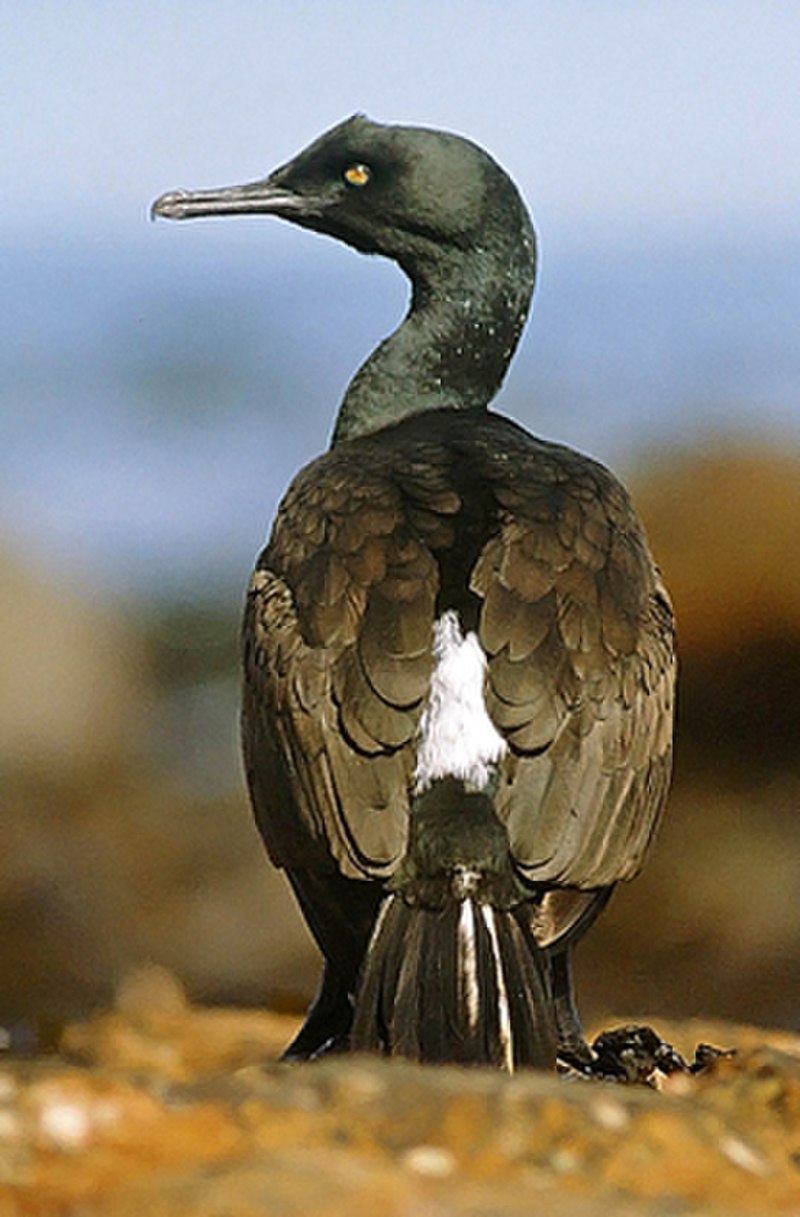
The Bank Cormorant is a bird endemic to Namibia and the western seaboard of South Africa, living in coastal waters up to 15 km offshore.
It has a large body measuring 75 cm long with black feathers that have a bronze sheen.
Its head features bright yellow eyes and an orange-yellow bill that curves downwards slightly at the tip.
The underside of its wings are white while its feet have black webbed toes for swimming gracefully through water bodies like lakes, rivers and lagoons where it searches for fish on which it feeds heavily as part of its diet.
This bird also flaps their wing rapidly when drying them after coming out from fishing activities or during bathing sessions inside water bodies.Scientific classification:
| Kingdom | Animalia |
| Phylum | Chordata |
| Class | Aves |
| Order | Suliformes |
| Family | Phalacrocoracidae |
| Genus | Phalacrocorax |
| Species | P. neglectus |
38. Red-Knobbed Coot
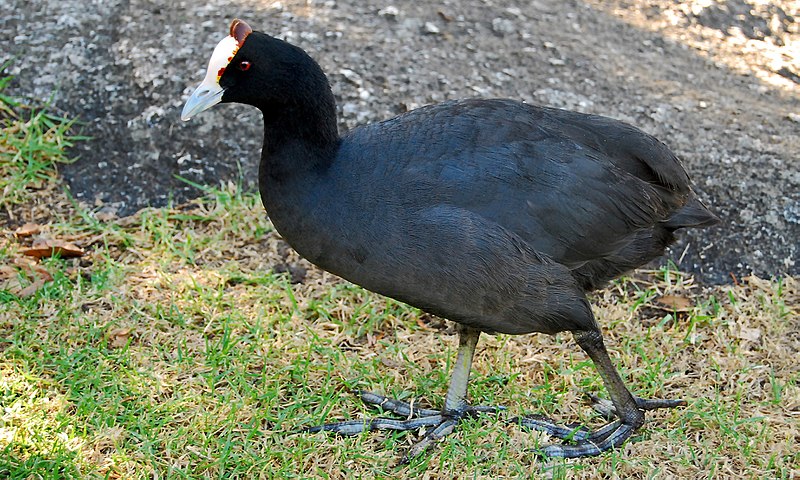
The Red-knobbed Coot is a species of rail and crake bird belonging to the Rallidae family. It is mostly found in Africa with presence in parts of southern Spain, breeding around freshwater lakes and ponds.
They build their nest from dead reeds near water’s edge or on floating platforms, laying about seven eggs but can lay more depending on environmental factors.
It was formally described by Italian ornithologist Giovanni Antonio Scopoli in 1786 as Fulica cristata which translates to “crested coot” due its distinctive red knob located above the bill that it uses for display purposes during courtship rituals.
The Red-knobbed Coot has a black body with white beak and feet, making them quite easy to spot amongst other birds native to similar habitats.Scientific classification:
| Kingdom | Animalia |
| Phylum | Chordata |
| Class | Aves |
| Order | Gruiformes |
| Family | Rallidae |
| Genus | Fulica |
| Species | F. cristata |
Also Featured In: Most Common Spain Birds, Most Popular Birds in Mallorca
39. Cape Teal
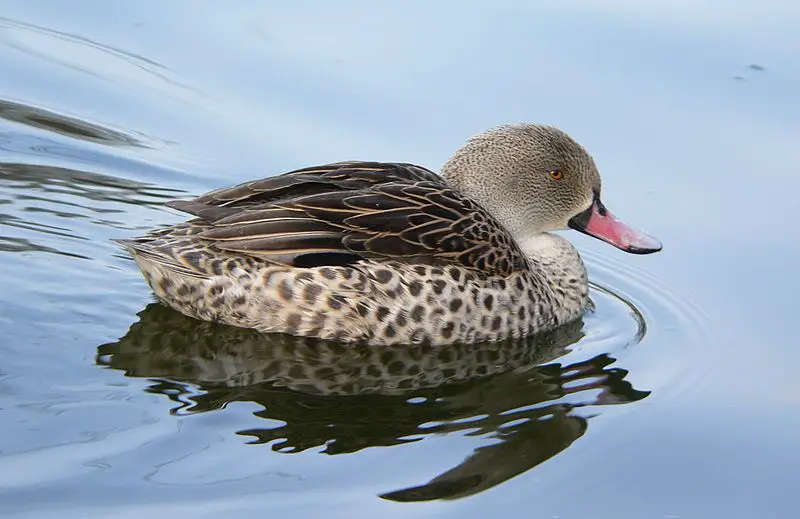
The Cape Teal is a medium-sized dabbling duck native to sub-Saharan Africa. Measuring between 44 and 46 centimetres in length, it has a distinctive black head with white eye patches, along with greenish wings and chestnut sides.
It feeds on aquatic invertebrates and plants found in wetlands such as marshes, lagoons, estuaries and rivers.
The species was first described by German naturalist Johann Friedrich Gmelin in 1789 – he placed it within the genus Anas alongside ducks, geese and swans.
This beautiful bird can be seen near water bodies all across its range where suitable habitat exists for them to thrive.Scientific classification:
| Kingdom | Animalia |
| Phylum | Chordata |
| Class | Aves |
| Order | Anseriformes |
| Family | Anatidae |
| Genus | Anas |
| Species | A. capensis |
40. African Emerald Cuckoo
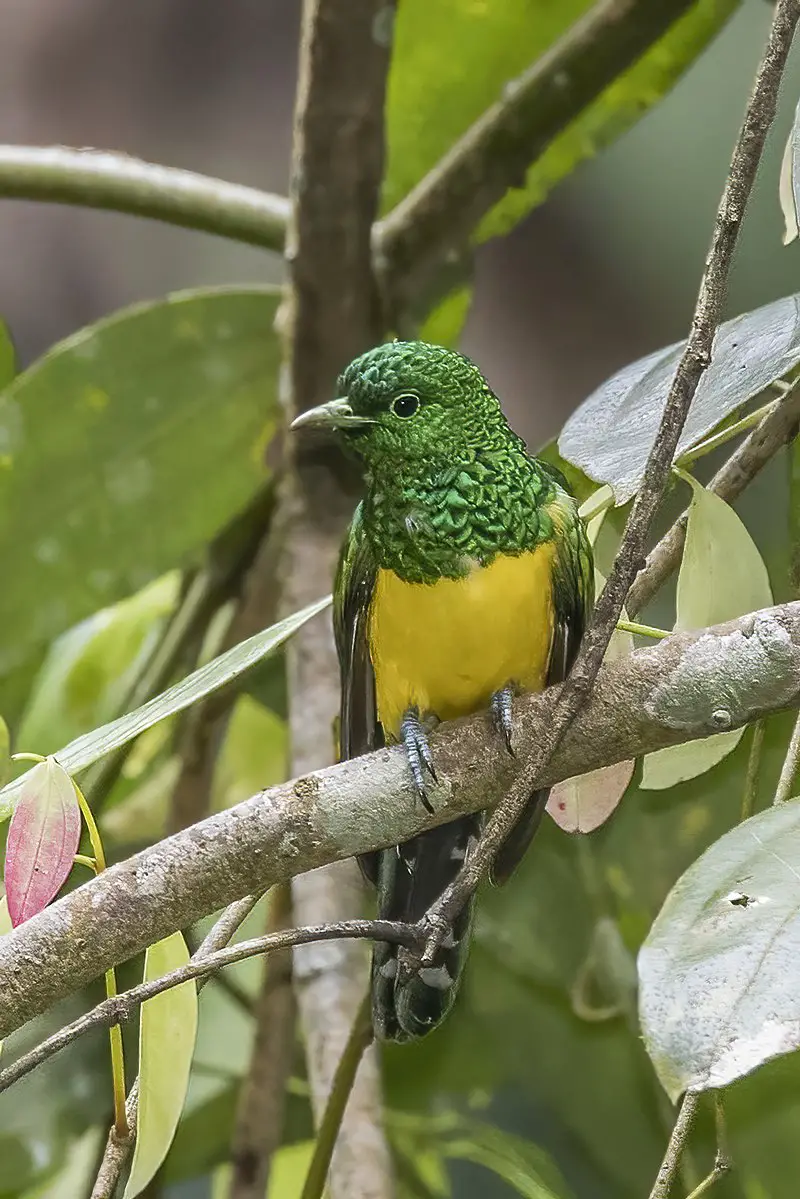
The African emerald cuckoo is a species of Old World cuckoo that can be found across much of sub-Saharan Africa.
It has four unique subspecies, C.c. cupreus, C.c sharpei, C.c intermedius and insularum which have adapted to their respective areas in the continent over time and are distinguishable by minor differences such as size or plumage colouration.
This bird feeds mainly on arthropods but will also consume fruit from trees like mangoes when available during its breeding season spanning from December to April depending upon location.
The female lays eggs directly into other birds’ nests without them knowing for it raise her own young with no effort required by her; this behavior gives the species its name ‘Cuckoo’ as it is thought to mimic the sound made by these birds within their habitat.Scientific classification:
| Kingdom | Animalia |
| Phylum | Chordata |
| Class | Aves |
| Order | Cuculiformes |
| Family | Cuculidae |
| Genus | Chrysococcyx |
| Species | C. cupreus |
41. Klaas’s Cuckoo
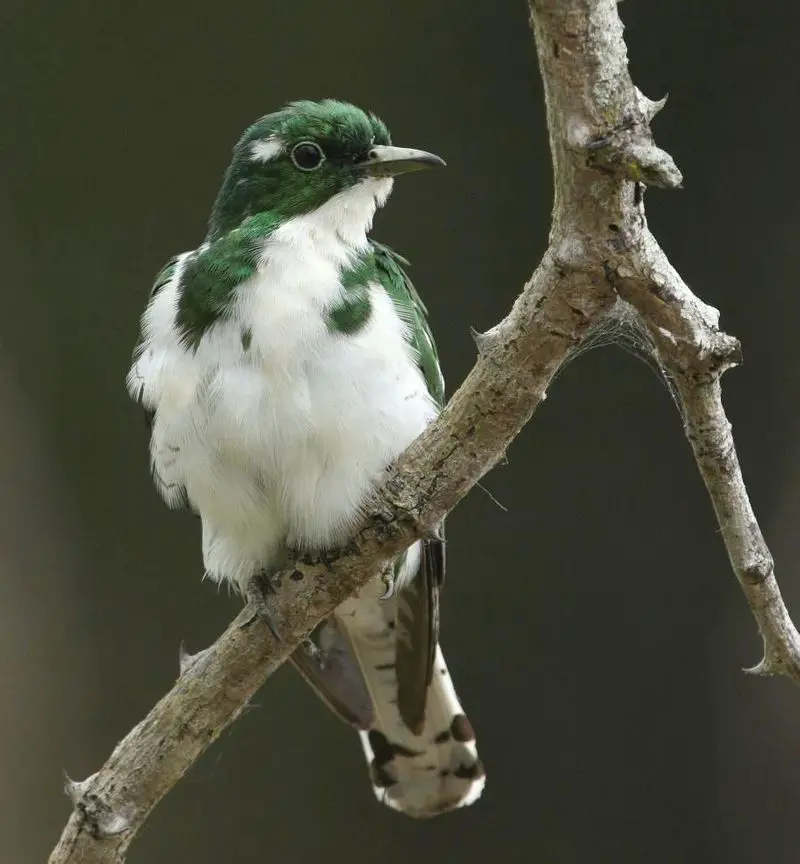
Klaas’s cuckoo is a species of bird found in the wooded areas of sub-Saharan Africa.
The unique species was named after Klaas, the Khoikhoi man who collected the first specimen and presented it to French explorer François Le Vaillant in 1806.
It belongs to the family Cuculidae which encompasses many cuckoos around the world including Old World cuckoos native to Eurasia and New World tropical cuckoos from Central and South America.
This small bird can be identified by its greyish back, white belly with dark streaks on either side, yellowish brown wings with black tips along tail feathers, red eyes, pale bill and blue legs.
Its diet consists mainly of insects such as caterpillars while they are also known for their parasitic behaviour where they lay eggs inside other birds’ nests instead of building their own nest or incubating them themselves.
All in all , Klaas’s cukcoo is an interesting yet enigmatic creature that has been studied for centuries but still holds much mystery about itself.Scientific classification:
| Kingdom | Animalia |
| Phylum | Chordata |
| Class | Aves |
| Order | Cuculiformes |
| Family | Cuculidae |
| Genus | Chrysococcyx |
| Species | C. klaas |
42. Black Cuckoo
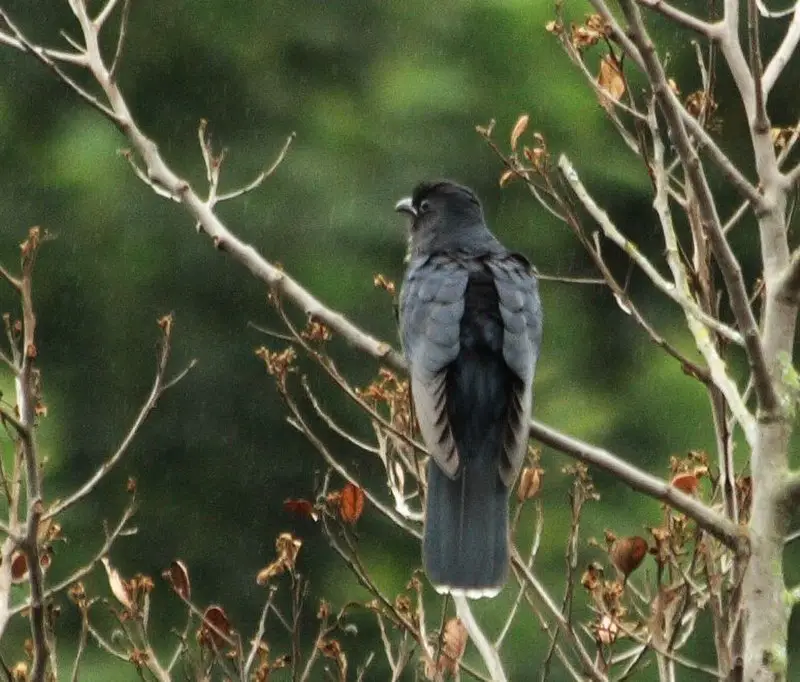
The Black Cuckoo is a species of cuckoo native to sub-Saharan Africa. It has two distinct subspecies and is classified as “Least Concern” by the International Union for Conservation of Nature due to its wide range and high population numbers.
This bird measures about 32 cm in length, with males slightly larger than females. Its plumage varies from black or grey on its upperparts, while it’s underparts are white or light grey in colour, sometimes flecked with darker markings.
The wings have dark outer feathers but barred inner ones; the tail is rounded and usually blackish brown above while being whitish underneath.
This cuckoo feeds mainly on insects such as beetles and caterpillars which it finds amongst foliage or along woodland edges, occasionally also taking berries when available.
A distinctive call can be heard throughout much of their distribution area during breeding season – consisting of a soft ‘coo’ followed by an upward trill that increases in pitch at the end.Scientific classification:
| Kingdom | Animalia |
| Phylum | Chordata |
| Class | Aves |
| Order | Cuculiformes |
| Family | Cuculidae |
| Genus | Cuculus |
| Species | C. clamosus |
43. Red-Chested Cuckoo
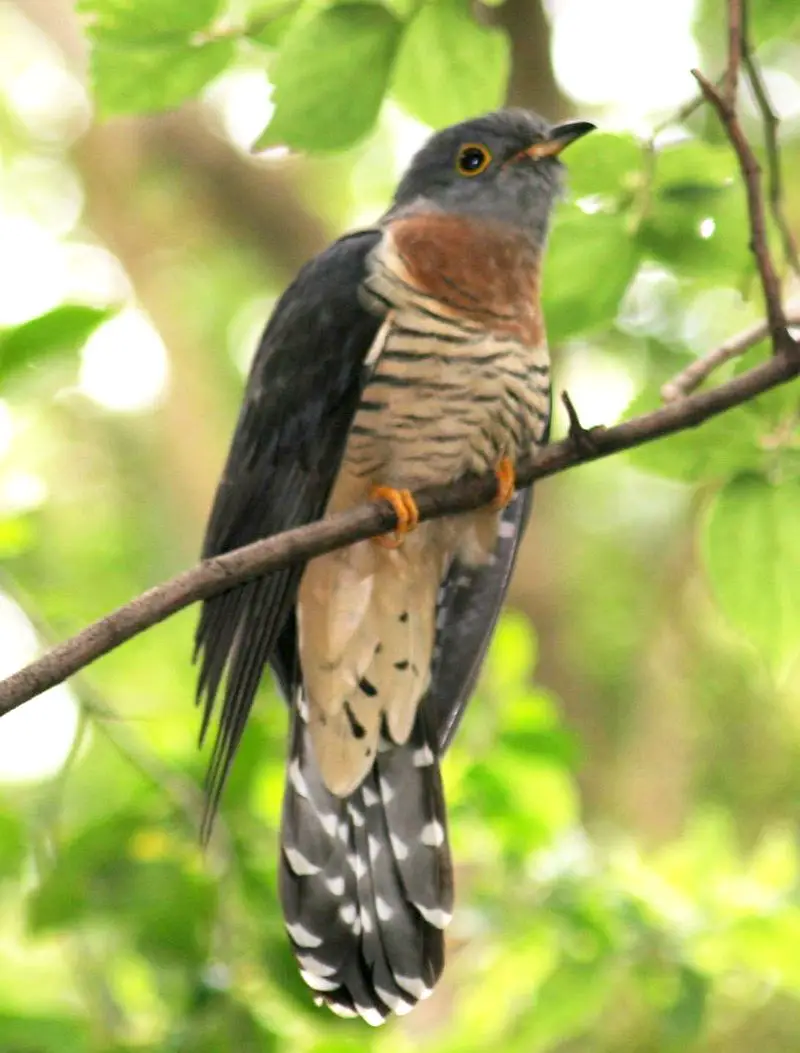
The red-chested cuckoo is a medium size bird, measuring at around 31 cm. It has slate grey upper parts and pale grey throat and sides of head.
The tail has dark grey tip with white spots on it that provide an extra decorative feature to the already beautiful bird.
Its call in Afrikaans is ‘Piet-my-vrou’, which adds to its charm as one can easily relate this wonderful sound to the majestic creature itself.
Inhabiting Africa south of the Sahara, these birds are generally found near woodlands areas or tropical rainforests where they feed upon insects such as caterpillars, grasshoppers and wild fruits like berries for sustenance.
Their nesting habits involve laying eggs in other species’ nests usually after having eaten up some of their host’s eggs first. This unique behavior makes them fascinating creatures indeed.Scientific classification:
| Kingdom | Animalia |
| Phylum | Chordata |
| Class | Aves |
| Order | Cuculiformes |
| Family | Cuculidae |
| Genus | Cuculus |
| Species | C. solitarius |
44. Blue Korhaan
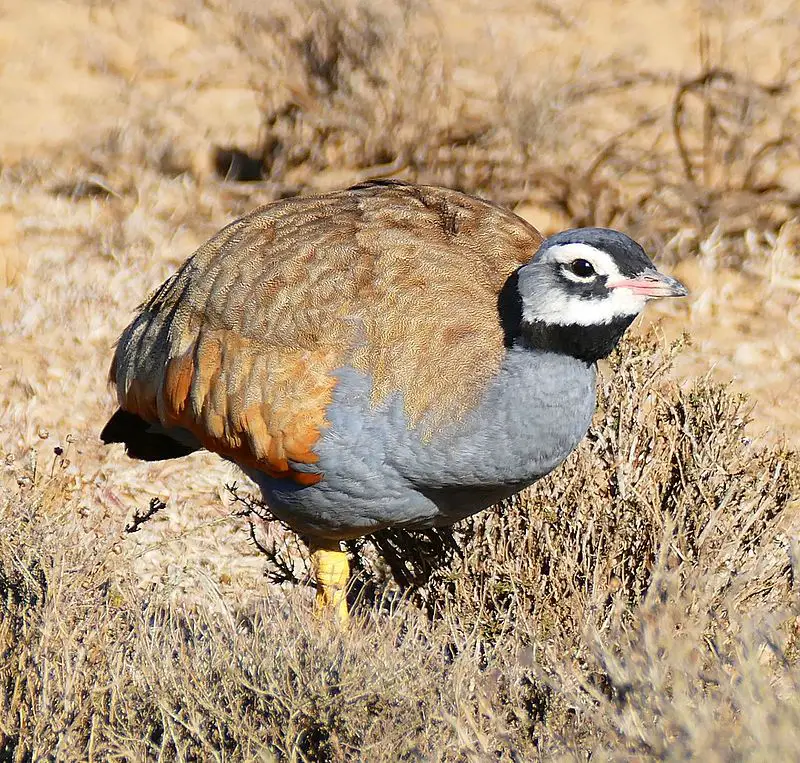
The Blue Korhaan is a species of bird found in South Africa, belonging to the family Otididae. It has blue plumage and its call consists of frog-like croaks which are often uttered while flying.
Its habitat includes plateau grasslands, dry shrublands, arable land and pastureland. They prefer habitats with short grasses and flat terrain as they are ground-dwellers by nature.
These birds can be seen foraging on the ground or perched on low branches during their search for food such as insects, small lizards or fruits scattered across the landscape.
The endangered status of this species means that conservation efforts must be undertaken if we want it to survive into future generations.Scientific classification:
| Kingdom | Animalia |
| Phylum | Chordata |
| Class | Aves |
| Order | Otidiformes |
| Family | Otididae |
| Genus | Eupodotis |
| Species | E. caerulescens |
45. African Olive Pigeon
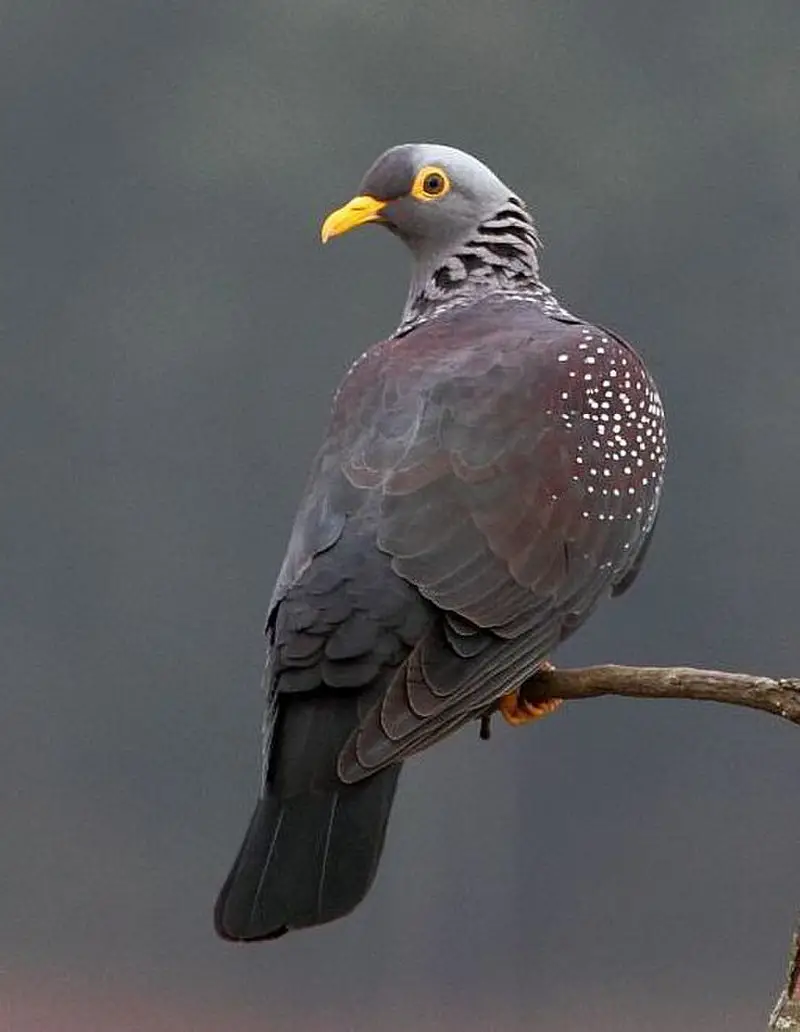
The African olive pigeon is a common resident of eastern and southern Africa, as well as parts of Angola, Saudi Arabia and Yemen.
It has beautiful gray-brown feathers with white spots on its wings.
The adult male bird displays an iridescent green neck patch while the female lacks this distinctive coloration.
This species prefers open woodland areas or savannas where they feed primarily on seeds, fruits and buds found in tall trees or shrubs.
When breeding it builds a flimsy platform nest located high up in a tree canopy to lay two eggs which hatch after 14 days incubation period by both parents caring for their young until fledging at around 28 days old.Scientific classification:
| Kingdom | Animalia |
| Phylum | Chordata |
| Class | Aves |
| Order | Columbiformes |
| Family | Columbidae |
| Genus | Columba |
| Species | C. arquatrix |
46. Southern Black Korhaan
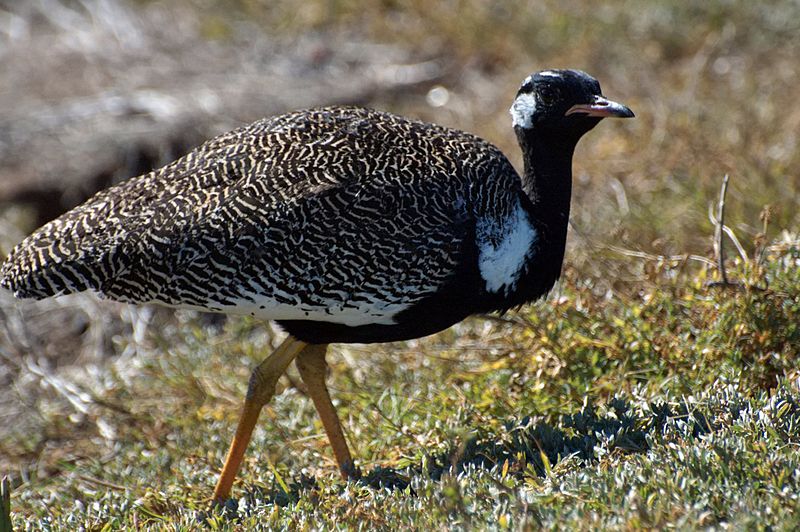
The Southern black korhaan, also known as the black bustard, is a species of bird found in southwestern South Africa. It can be distinguished by its small size and dark plumage.
This ground-dwelling species inhabits semi-arid habitats such as grasslands, shrublands and savannas where it preys on arthropods and feeds on seeds. The range of this species extends from Namaqualand to Cape Town in the south and Makhanda in the east.
Conservation efforts for this bird have been undertaken due to habitat loss caused by various human activities like farming, overgrazing and urbanisation which has led to a decrease population numbers making them vulnerable to threats from predators or environmental changes.Scientific classification:
| Kingdom | Animalia |
| Phylum | Chordata |
| Class | Aves |
| Order | Otidiformes |
| Family | Otididae |
| Genus | Afrotis |
| Species | A. afra |
47. Cape Spurfowl
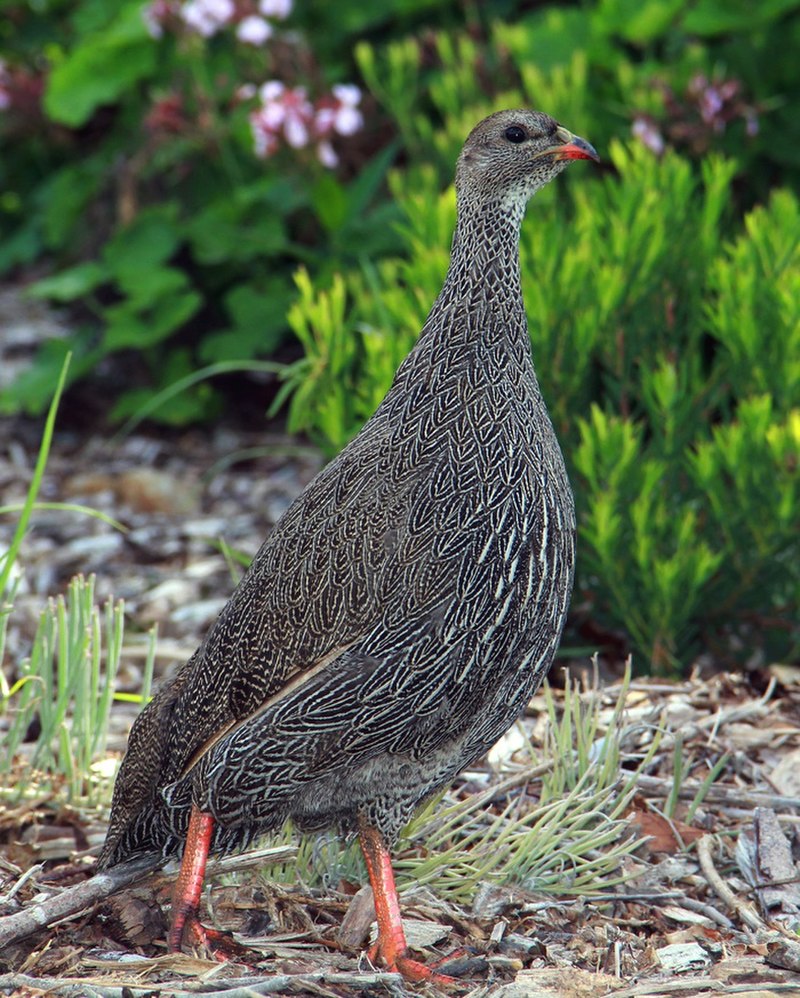
The Cape Spurfowl is a large gamebird native to southern Africa. It can be found in the Western Cape province of South Africa, and parts of Namibia. This bird has adapted well to human-altered habitats such as alien vegetation and urban areas.
Although it does prefer scrubby roosting spaces for nesting, it doesn’t need them to survive. The female lays up to 20 eggs at one time which have greyish brown speckles on both sides that help camouflage them from predators while they incubate during the day and hatch after 21 days or so.
They are omnivores with a diet consisting mainly of small fruits, seeds, insects & other invertebrates including spiders & worms; making them an important part of their local ecosystem by helping disperse food sources among animal species living nearby.Scientific classification:
| Kingdom | Animalia |
| Phylum | Chordata |
| Class | Aves |
| Order | Galliformes |
| Family | Phasianidae |
| Genus | Pternistis |
| Species | P. capensis |
48. Water Thick-Knee
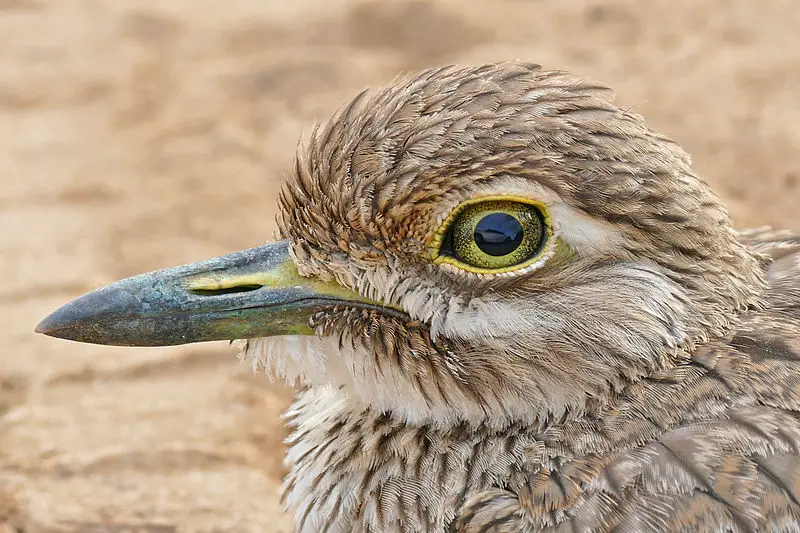
The Water thick-knee is a species of bird belonging to the Burhinidae family. It has a wide distribution in sub-Saharan Africa, where it can be found near waterbodies such as rivers, lakes and wetlands.
Its plumage is dark brown above with white spots on its wings, while below it is mostly greyish or whitish.
The bill is long and straight with yellow legs and feet. During breeding season they are more vocal than usual making loud calls during the night time hours that sound like “keh keh”.
This bird feeds mainly on insects but also takes small reptiles, crustaceans and molluscs from shallow waters when available.
Breeding pairs construct scrapes within grassy areas which they use for nesting sites during the dry season months between July to September depending on locationScientific classification:
| Kingdom | Animalia |
| Phylum | Chordata |
| Class | Aves |
| Order | Charadriiformes |
| Family | Burhinidae |
| Genus | Burhinus |
| Species | B. vermiculatus |
49. Kelp Gull
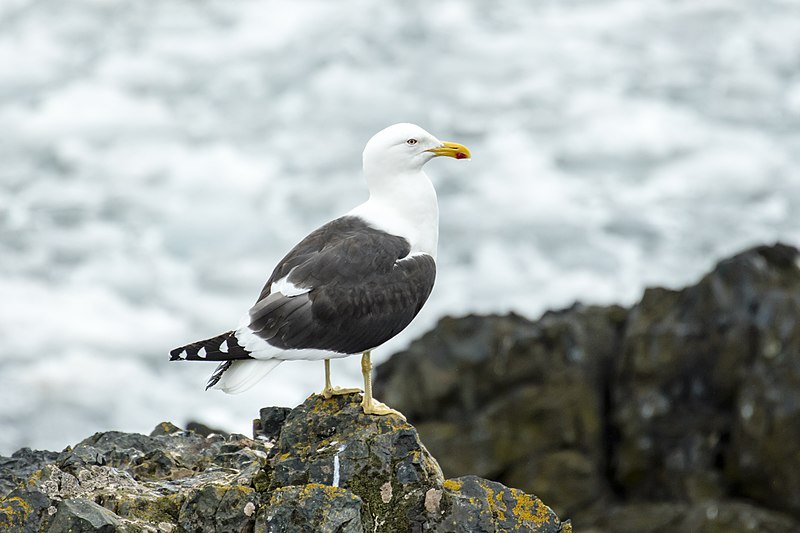
The Kelp Gull is a majestic bird that can be found on coasts and islands of the Southern Hemisphere. It has a beautiful plumage consisting of black, white and grey feathers with brown eyes.
Its wingspan ranges between 91-122 cm (36 – 48 inches). The nominate L. d. dominicanus subspecies is most commonly seen around South America, parts of Australia, and New Zealand where it goes by the name “black-backed gull” or “mollyhawk”.
These birds are omnivorous but tend to prefer fish as their primary food source while they also scavenge carrion when necessary.
In order to stand out from other seagulls during mating season they display vibrant courtship rituals which involve flying high in circles over its nesting area flapping their wings dramatically before diving down into the water near potential mates.Scientific classification:
| Kingdom | Animalia |
| Phylum | Chordata |
| Class | Aves |
| Order | Charadriiformes |
| Family | Laridae |
| Genus | Larus |
| Species | L. dominicanus |
Also Featured In: Most Common Birds in South America Birds, Patagonia Birds You Should Know
50. African Green Pigeon
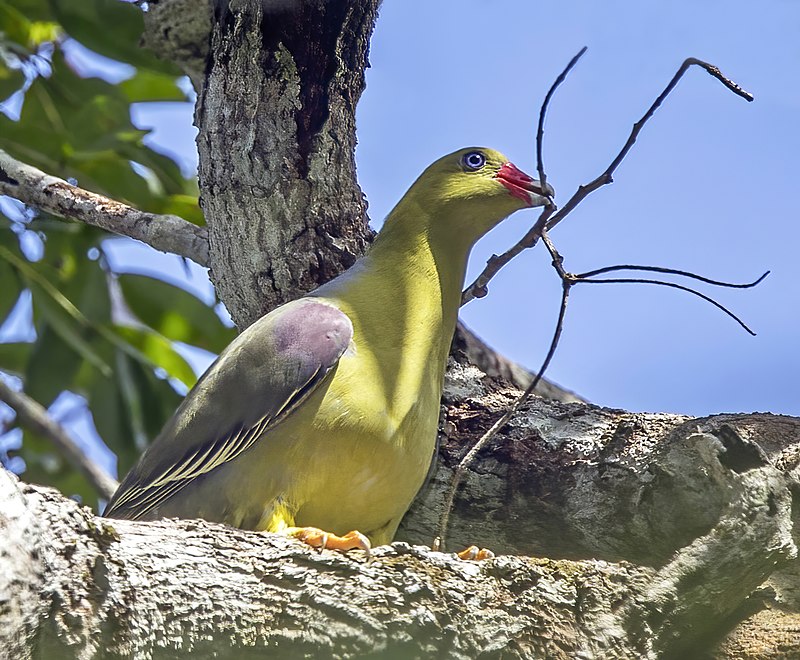
The African green pigeon is an incredibly unique bird that inhabits the Sub-Saharan Africa region.
It has a wide range of accepted races, and its adults have maroon patches on their wings while juveniles are olive in color.
Its upperparts can be grayish-green to yellowish-green with a white throat, barred underparts and clean legs. This species feeds mainly on fruit but may also consume seeds or insects.
It typically nests in trees near water or swamps where it builds platforms made from twigs for laying eggs which hatch after 2 weeks of incubation period by both parents sharing the duties equally .
The African green pigeon is quite vocal during mating season as well as when alarmed; often using whistles “kiu” notes to communicate with each other in flocks up to 30 birds at a time.Scientific classification:
| Kingdom | Animalia |
| Phylum | Chordata |
| Class | Aves |
| Order | Columbiformes |
| Family | Columbidae |
| Genus | Treron |
| Species | T. calvus |